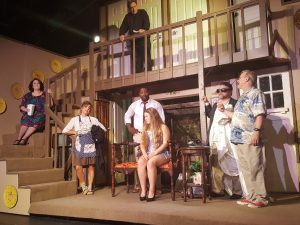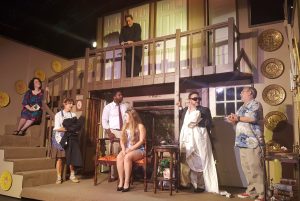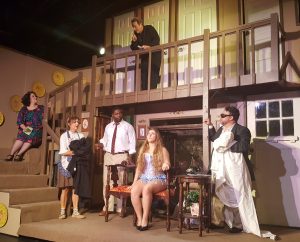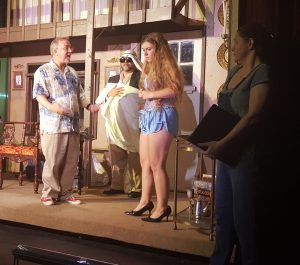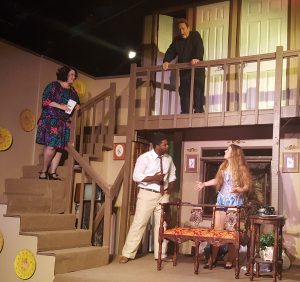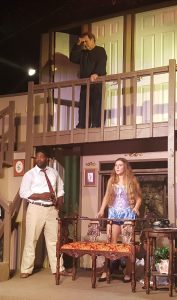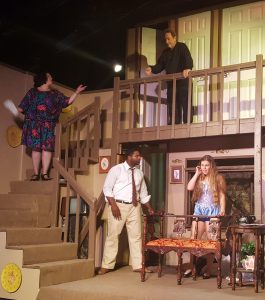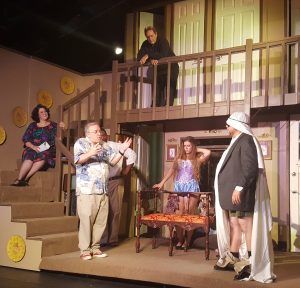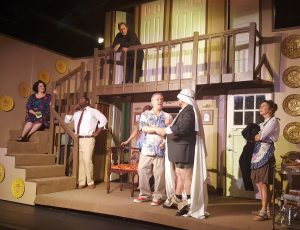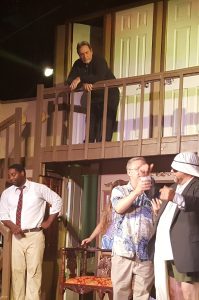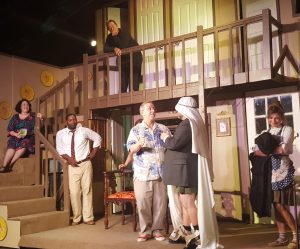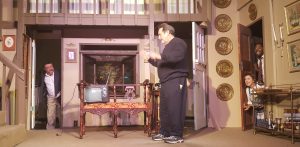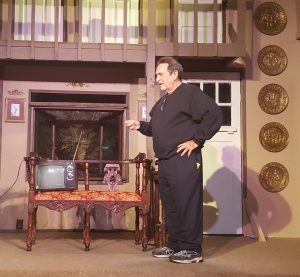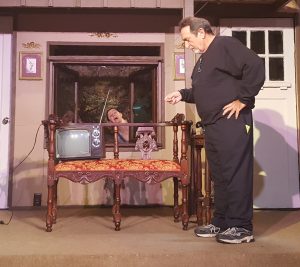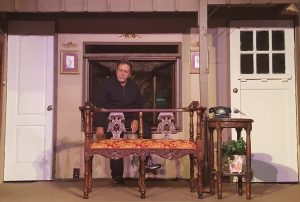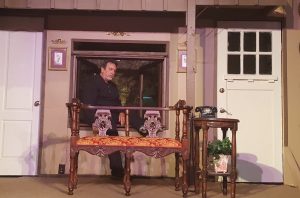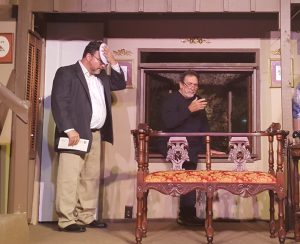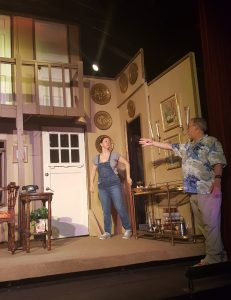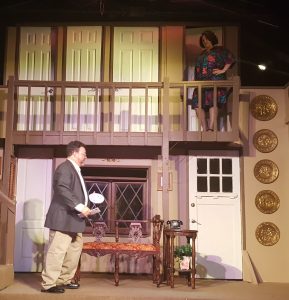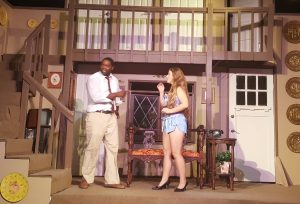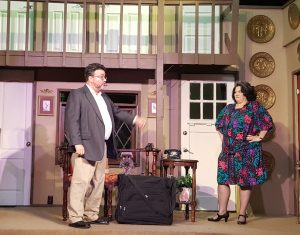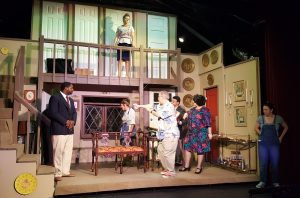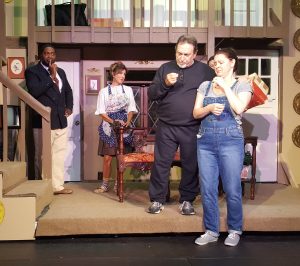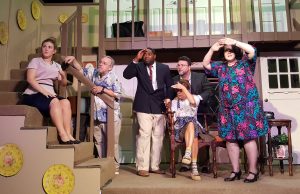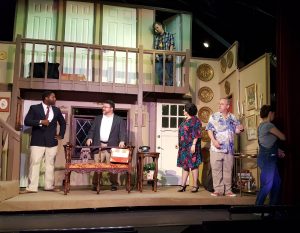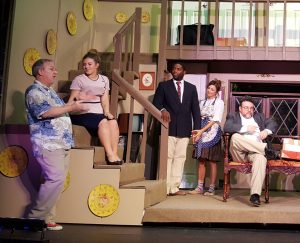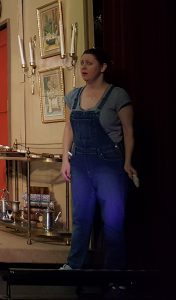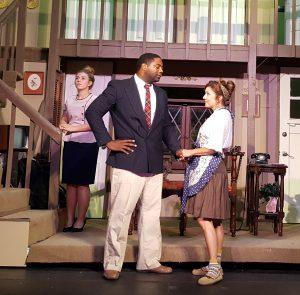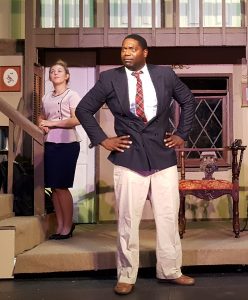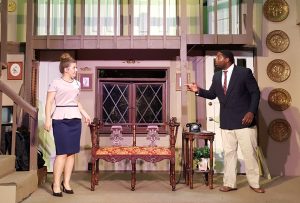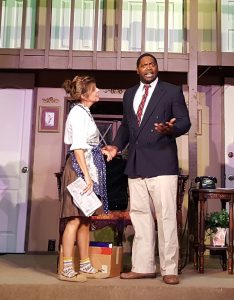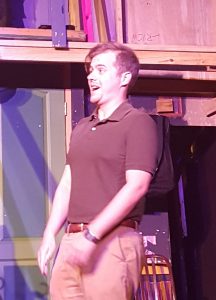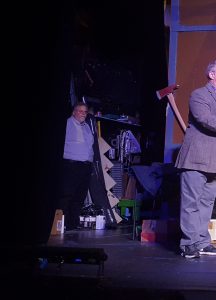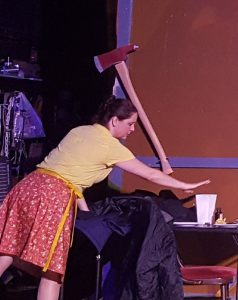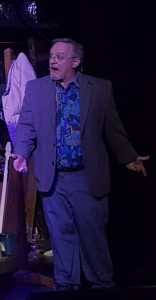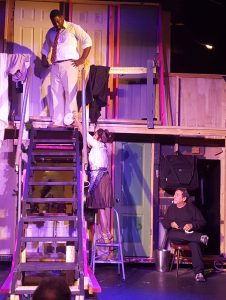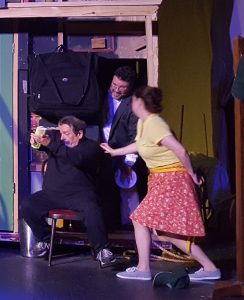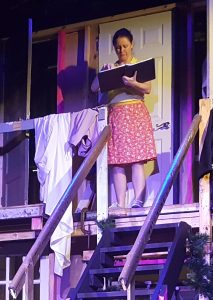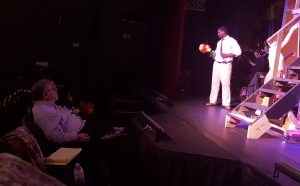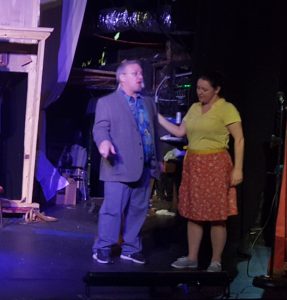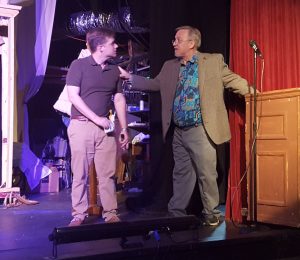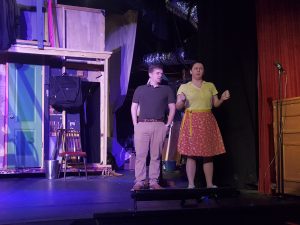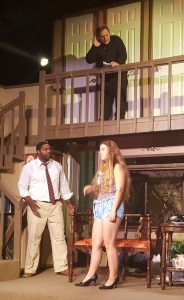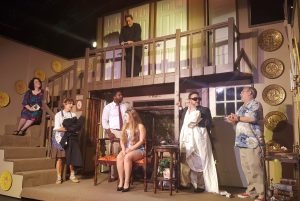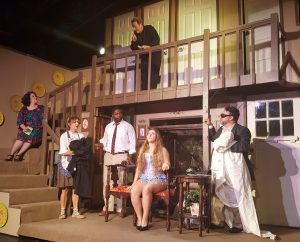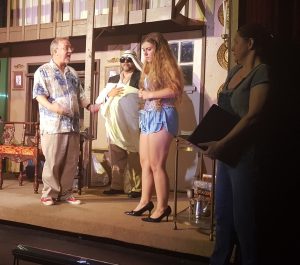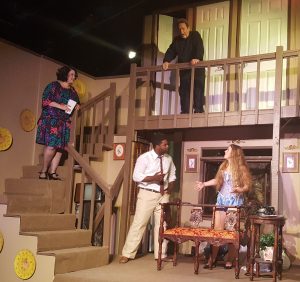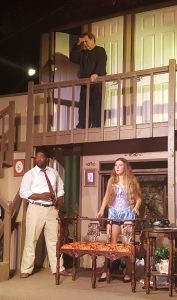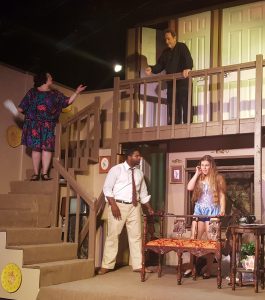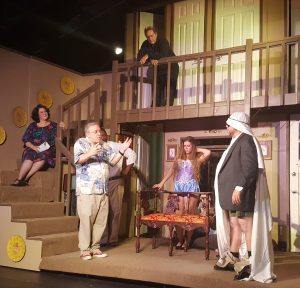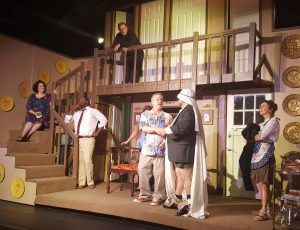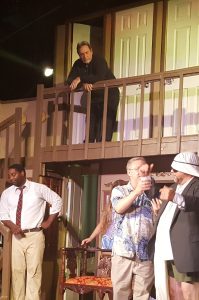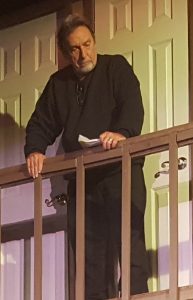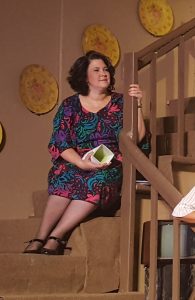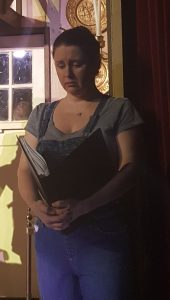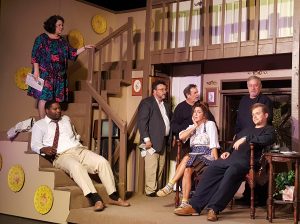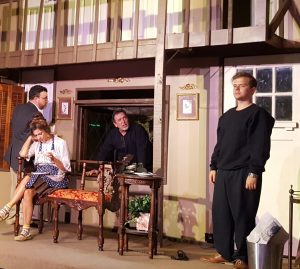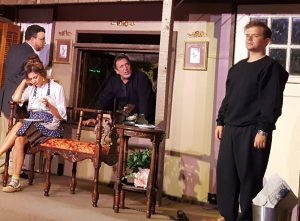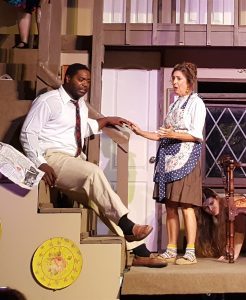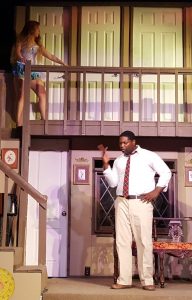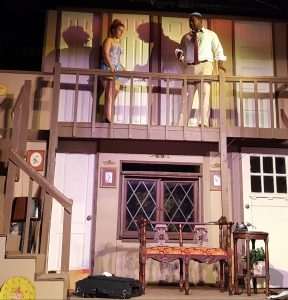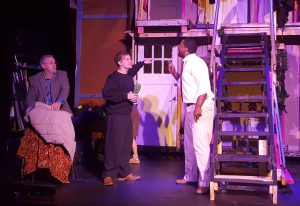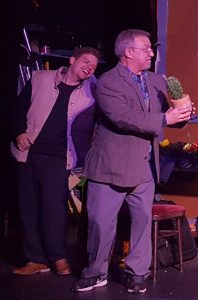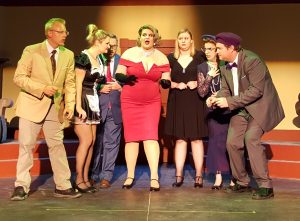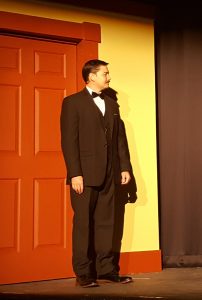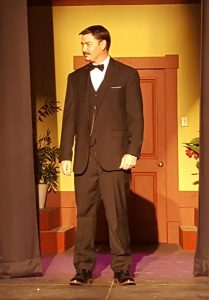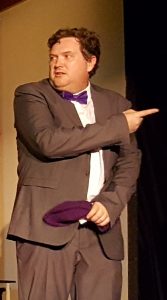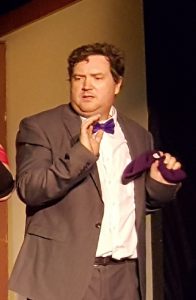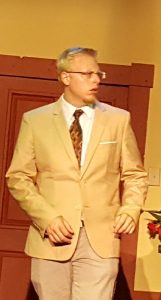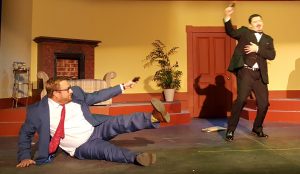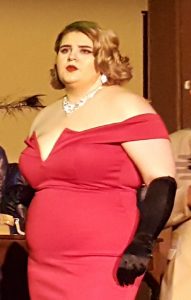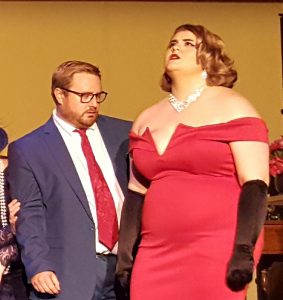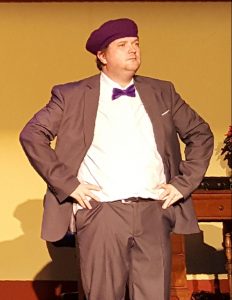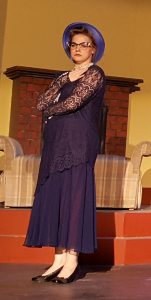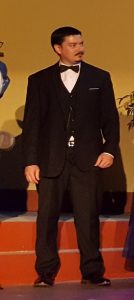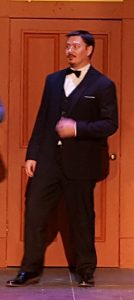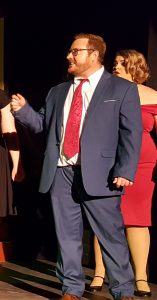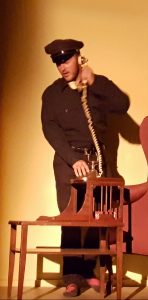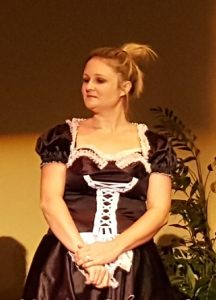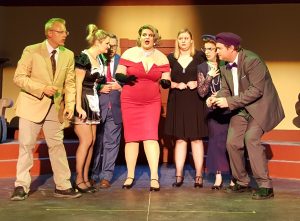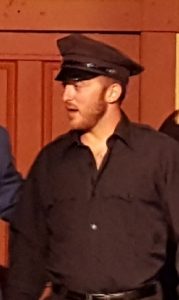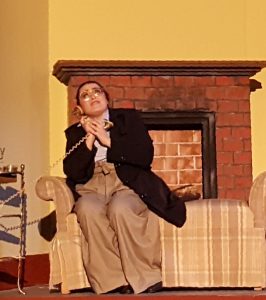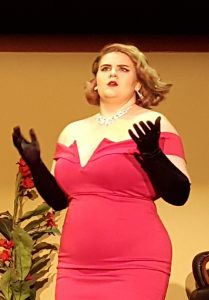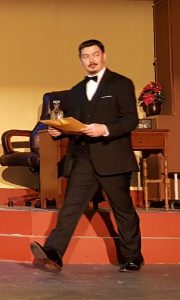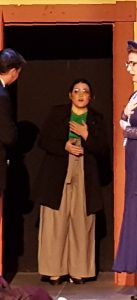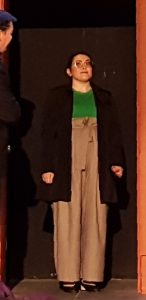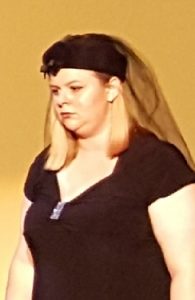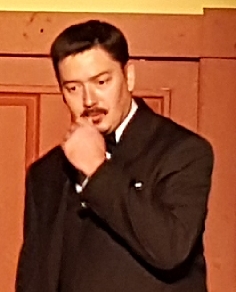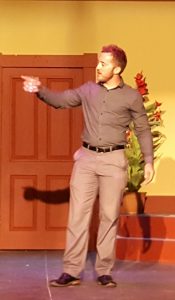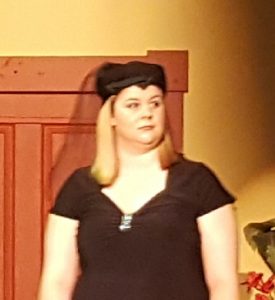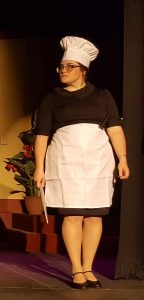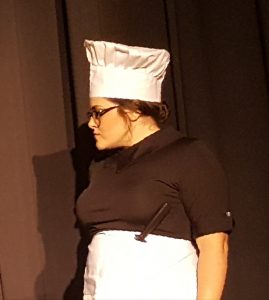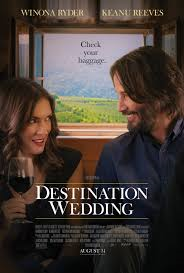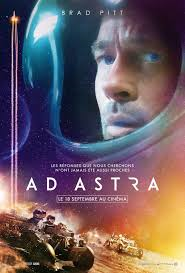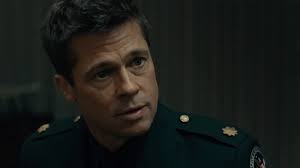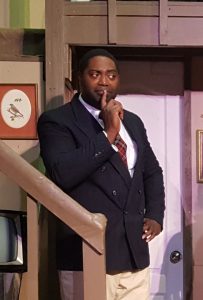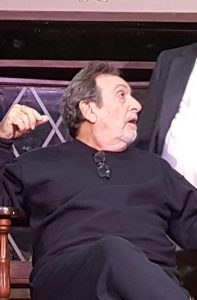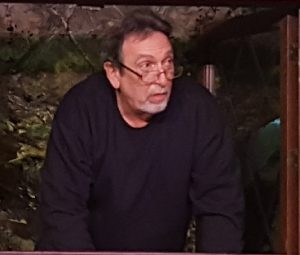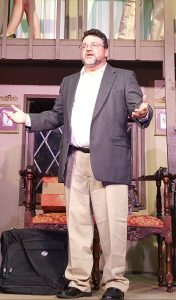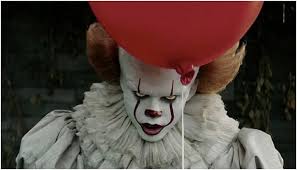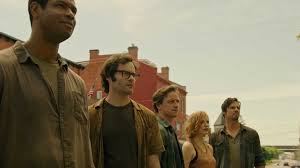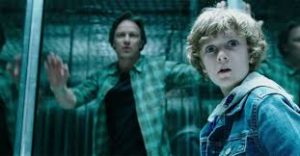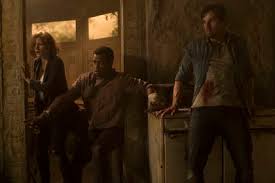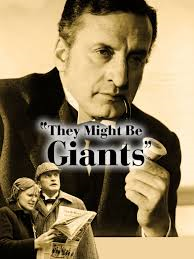AND EVEN MORE PHOTOS FOR NOISES OFF
MORE PHOTOS FOR NOISES OFF
CLUE – FROM BOARD GAME TO MOVIE TO STAGE – PLAYING THIS MONTH AT ACTS THEATRE
SHORT TAKE:
Mostly family friendly spoof on murder mysteries, based on the board game of the same name and translated from the eponymous movie, Clue, playing at ACTS Theatre for the next three weekends – October 11 – October 27, 2019 – get your tickets HERE.
WHO SHOULD GO:
Everyone. Aside from a little bit of mild profanity and some very light jabs at religion and alternative lifestyles, this is a family friendly show. There’s no sexual activity, no real violence and the murders are part of the buffoonery and played for healthy laughs. Older people will get the jokes and kids will enjoy the slapstick.
LONG TAKE:
In 1945 Anthony Pratt invented a family past time based upon the idea of a murder mystery. He called it Cluedo but we all know it as 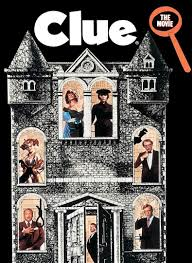 Clue. In the 1980’s John Landis
Clue. In the 1980’s John Landis 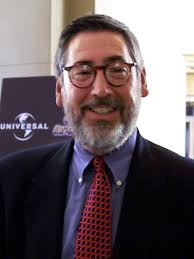 (director of Trading Places, Oscar and National Lampoon’s Animal House) became possessed with the idea of making Clue into a film. Despite being star studded and wielding a $15 million budget it flopped hard at the box office but has since become a cult sensation boasting of: a novelization, its own fan club, Youtubes coming to its defense, an off-Broadway musical, a campaign to remake it with Ryan Reynolds in the lead, and a live theatrical version.
(director of Trading Places, Oscar and National Lampoon’s Animal House) became possessed with the idea of making Clue into a film. Despite being star studded and wielding a $15 million budget it flopped hard at the box office but has since become a cult sensation boasting of: a novelization, its own fan club, Youtubes coming to its defense, an off-Broadway musical, a campaign to remake it with Ryan Reynolds in the lead, and a live theatrical version.
Landis’ Clue was the first of its kind, 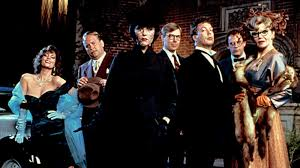 a movie made from a board game. It starred some of the most talented comedians of the time: Tim Curry, (who lists this along with Muppet Treasure Island as two of his own favorite movies in which he was cast), Madeline Kahn (Blazing Saddles, Young Frankenstein) whose now classic dry description of how much she hated one of the other characters “flames on the side of my face”
a movie made from a board game. It starred some of the most talented comedians of the time: Tim Curry, (who lists this along with Muppet Treasure Island as two of his own favorite movies in which he was cast), Madeline Kahn (Blazing Saddles, Young Frankenstein) whose now classic dry description of how much she hated one of the other characters “flames on the side of my face” 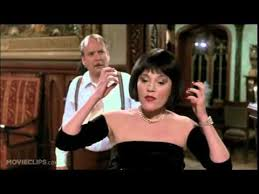 left fellow cast mates struggling to maintain their professional composure during the scene and was the only ad lib allowed to stay in the tightly disciplined and rehearsed shooting schedule, Martin Mull (FM, Jingle all the Way and guest spots on a zillion TV shows), Christopher Lloyd (Back to the Future, and the classic TV show Taxi), Eileen Brennan (FM, The Sting, and another parody murder comedy Murder by Death), Leslie Ann Warren (Rodgers & Hammerstein’s Cinderella, Victor/Victoria), and Michael McKean (Laverne and Shirley).
left fellow cast mates struggling to maintain their professional composure during the scene and was the only ad lib allowed to stay in the tightly disciplined and rehearsed shooting schedule, Martin Mull (FM, Jingle all the Way and guest spots on a zillion TV shows), Christopher Lloyd (Back to the Future, and the classic TV show Taxi), Eileen Brennan (FM, The Sting, and another parody murder comedy Murder by Death), Leslie Ann Warren (Rodgers & Hammerstein’s Cinderella, Victor/Victoria), and Michael McKean (Laverne and Shirley).
I mention all this to point out what big shoes the cast and crew for ACTS latest production of the theatrical Clue have to fill, and fill them they do.
 The story concerns a group of strangers who gather at the summons of a mysterious stranger, aptly named Mr. Boddy, (no that is not a misspelling) to a spooky and isolated house on a stormy night for an evening of revelations. The guests get more than they bargained for. With characters named and colorfully costumed in keeping with the pieces in the Clue game, in a house laid out like the original Hasbro product, it becomes immediately apparent that there will be far more vaudeville than violence and more mugging than mayhem. Pratfalls and slapstick laughs are the coinage of the evening as fun is poked at the genre which has long been home to the likes of the far more austere Agatha Christie and Sherlock Holmes.
The story concerns a group of strangers who gather at the summons of a mysterious stranger, aptly named Mr. Boddy, (no that is not a misspelling) to a spooky and isolated house on a stormy night for an evening of revelations. The guests get more than they bargained for. With characters named and colorfully costumed in keeping with the pieces in the Clue game, in a house laid out like the original Hasbro product, it becomes immediately apparent that there will be far more vaudeville than violence and more mugging than mayhem. Pratfalls and slapstick laughs are the coinage of the evening as fun is poked at the genre which has long been home to the likes of the far more austere Agatha Christie and Sherlock Holmes.
Stepping up to the plate for the inimitable Mr. Landis to direct is our own  Clay Hebert, veteran of decades of productions all over Lake Charles from McNeese to ACTS to Lake Charles Little Theater and even Hollywood, for whom this play has been a two year dream project.
Clay Hebert, veteran of decades of productions all over Lake Charles from McNeese to ACTS to Lake Charles Little Theater and even Hollywood, for whom this play has been a two year dream project.
Clever use is made of the stage in which quick changes and even quicker stage hands move props on and off to represent the many rooms of the house and in the board game: hall, library, study, etc.
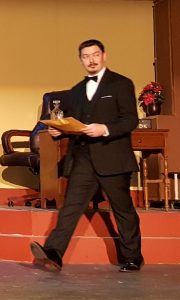 Wadsworth, the butler and audience liason, is played by Aaron Webster ( just having finished a similarly sinister role in Arsenic and Old Lace for ACTS). Mrs. White is
Wadsworth, the butler and audience liason, is played by Aaron Webster ( just having finished a similarly sinister role in Arsenic and Old Lace for ACTS). Mrs. White is  Kelly Rowland (also from Arsenic) who can’t seem to resist roles of sweetly homicidal ladies.
Kelly Rowland (also from Arsenic) who can’t seem to resist roles of sweetly homicidal ladies.  Dylan Conley is Colonel Mustard. Miss Scarlet is played by
Dylan Conley is Colonel Mustard. Miss Scarlet is played by 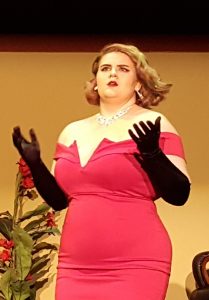 Taylor Novak-Tyler (Steel Magnolias and Dirty Rotten Scoundrels).
Taylor Novak-Tyler (Steel Magnolias and Dirty Rotten Scoundrels). 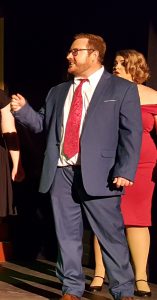 Robert Goodson (Dirty Rotten Scoundrels, Spamalot) lends his unique brand of physical comedy to liven up Mr. Green.
Robert Goodson (Dirty Rotten Scoundrels, Spamalot) lends his unique brand of physical comedy to liven up Mr. Green.  Stacy Solak (recently in Bye Bye Birdie) is a scene stealing Mrs. Peacock, and does double duty as aide-de-camp to Clay in the offstage role of assistant director.
Stacy Solak (recently in Bye Bye Birdie) is a scene stealing Mrs. Peacock, and does double duty as aide-de-camp to Clay in the offstage role of assistant director.  Zac Hammons (Dirty Rotten Scoundrels) is Professor Plum. Yvette, the maid – not a board game piece but a character from the movie – is played by
Zac Hammons (Dirty Rotten Scoundrels) is Professor Plum. Yvette, the maid – not a board game piece but a character from the movie – is played by  Kaylen Peters. Similar to the way the Swiss Army Knife of performers who portrayed a multiplicity of characters was used in The 39 Steps,
Kaylen Peters. Similar to the way the Swiss Army Knife of performers who portrayed a multiplicity of characters was used in The 39 Steps, 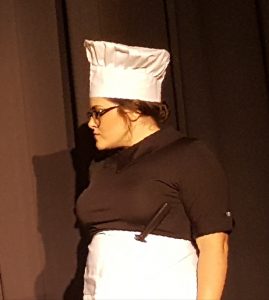
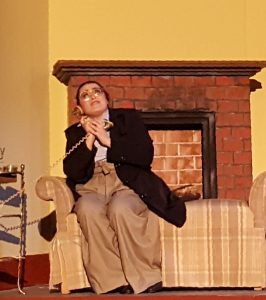 Lauren Manuel and
Lauren Manuel and 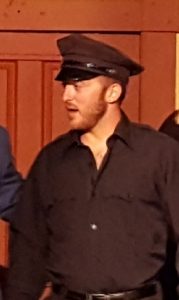
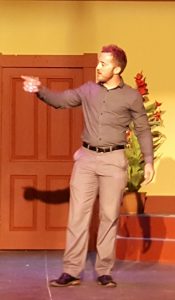 Lewis Paxton fill in variously for: Mr. Boddy, the Cook, the Motorist, the Singing Telegram Girl, and Police Officers.
Lewis Paxton fill in variously for: Mr. Boddy, the Cook, the Motorist, the Singing Telegram Girl, and Police Officers.
Lending their respective wifely supports as well as extraordinary talents to this production in general and Aaron Webster and Clay Hebert in particular are  Kris Webster and
Kris Webster and  Markie Hebert who functioned as co-producers.
Markie Hebert who functioned as co-producers.
A brave  Catheryn Fredericks helps wrangle this motley crew of comedians together as the stage manager.
Catheryn Fredericks helps wrangle this motley crew of comedians together as the stage manager.
MILD SPOILER
Sorry movie fans – 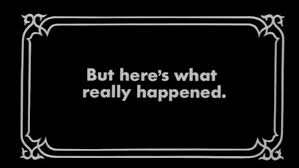 – there is only one ending.
– there is only one ending.
So go join this humorously homicidal troupe as they give it their all to give you a ….. Clue.
 TICKETS HERE.
TICKETS HERE.
BEYOND HERE BE POSSIBLE SPOILERS SO CONTINUE AT YOUR OWN RISK — OH WAIT THAT’S DIFFERENT BOARD GAME……
DESTINATION WEDDING – ODD ROM COM THAT WORKS AGAINST EXPECTATION
SHORT TAKE:
Unusual tale of how two unpleasant people create a positive relationship through a series of conversations at a weekend destination wedding.
WHO SHOULD GO:
Absolutely only adults and preferably married ones at that for: profanity, casual blasphemy and an explicit, albeit genuinely funny and fully clothed, scene of realistically portrayed sexual intimacy.
LONG TAKE:
A love story with a twist. To my knowledge this phrase was coined by my friend Franklin. He claims it an apt description to ANY movie. That may be so, but Destination Wedding really is one.
 While the movie doesn’t exactly turn the standard for the rom-com on its head it does view it obliquely. Destination Wedding certainly follows the formula: somewhat unlikely couple meet, after a few coincidental further encounters they find they have common interests, fall in love, run into obstacles to the relationship, etcetera. What’s different about Destination Wedding is both the structure of the movie and the characters.
While the movie doesn’t exactly turn the standard for the rom-com on its head it does view it obliquely. Destination Wedding certainly follows the formula: somewhat unlikely couple meet, after a few coincidental further encounters they find they have common interests, fall in love, run into obstacles to the relationship, etcetera. What’s different about Destination Wedding is both the structure of the movie and the characters.
Written and directed by Victor Levin, (who penned 29 episodes of the adorable rom-sitcom Mad About You), the movie would transit to the stage with ease. Much like a mobile My Dinner with Andre, the leads are the only people who have dialogue. 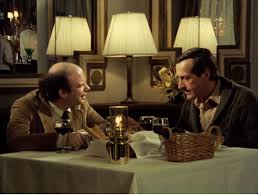 While My Dinner with Andre took place almost exclusively at a dinner table in a restaurant, Destination Wedding wanders all over different events’ settings: an airport, an airplane, the rehearsal dinner at a restaurant, the outdoor wedding, hotel rooms, etc. But the settings are barely noticed. The entire focus of the film is on the conversations between these two unlikely lovers, Lindsey and Frank.
While My Dinner with Andre took place almost exclusively at a dinner table in a restaurant, Destination Wedding wanders all over different events’ settings: an airport, an airplane, the rehearsal dinner at a restaurant, the outdoor wedding, hotel rooms, etc. But the settings are barely noticed. The entire focus of the film is on the conversations between these two unlikely lovers, Lindsey and Frank.
 You know the romance involved will be a bit different when it begins with the subtitle: “A narcissist can’t die because then the entire world would end.”
You know the romance involved will be a bit different when it begins with the subtitle: “A narcissist can’t die because then the entire world would end.”
Frank is played by Keanu Reeves, the titular action movie hero from 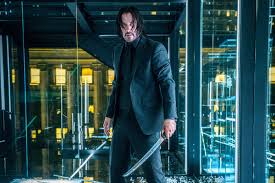 John Wick. Lindsey is played by Winona Ryder, most famously and recently as the frenetic mother, Joyce, desperately trying to protect her family from
John Wick. Lindsey is played by Winona Ryder, most famously and recently as the frenetic mother, Joyce, desperately trying to protect her family from 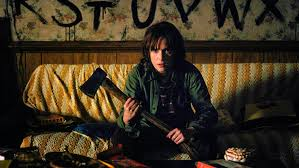 Stranger Things. Although there is no violence or supernatural killers in Destination Wedding, looking at the pictures from the lead actors’ current most notable respective roles one can see why there is a natural chemistry between the actors.
Stranger Things. Although there is no violence or supernatural killers in Destination Wedding, looking at the pictures from the lead actors’ current most notable respective roles one can see why there is a natural chemistry between the actors.
 Reeves here contributes to his too small stock of comedies. Reeves deadpan delivery is perfect for the emotionally distressed and extremely subdued Frank, who comes from a family which is extravagantly dysfunctional, and includes his half-brother, the groom. Cynically, Frank’s opinion of romance is summed up in his response to whether he believes there is someone for everyone.
Reeves here contributes to his too small stock of comedies. Reeves deadpan delivery is perfect for the emotionally distressed and extremely subdued Frank, who comes from a family which is extravagantly dysfunctional, and includes his half-brother, the groom. Cynically, Frank’s opinion of romance is summed up in his response to whether he believes there is someone for everyone. 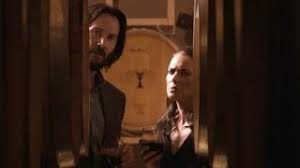 Frank retorts, “Close. I believe that there is nobody for anyone.” Lindsey, on the other hand, has a stable family background, but her problem is that she is still in love with the groom, and expresses her bitterness and frustration in self-absorption and constant critiques of others.
Frank retorts, “Close. I believe that there is nobody for anyone.” Lindsey, on the other hand, has a stable family background, but her problem is that she is still in love with the groom, and expresses her bitterness and frustration in self-absorption and constant critiques of others.
I once heard Dr. Laura Schlessinger describe her philosophy of a healthy relationship as finding someone whose quirks you don’t mind who doesn’t mind yours. Lindsey and Frank certainly have the quirks. The story examines whether their quirks will mesh comfortably or grind each other to pieces. 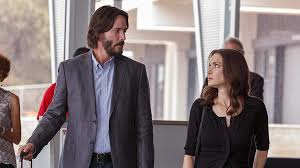 Like two oddly shaped puzzle pieces, the two rub each other the wrong way from their first casual conversation. But as they are both depressed outliers at this matrimonial celebration who find mutuality in hating the groom, avoiding the relatives and thinking the bride has “all the sense God gave a toaster,” they repeatedly end up ignored and forgotten by the wedding party at the different events – together.
Like two oddly shaped puzzle pieces, the two rub each other the wrong way from their first casual conversation. But as they are both depressed outliers at this matrimonial celebration who find mutuality in hating the groom, avoiding the relatives and thinking the bride has “all the sense God gave a toaster,” they repeatedly end up ignored and forgotten by the wedding party at the different events – together.
 Extreme dislike, like love, is a strong emotion which can be flipped on its head and the audience is entertained by watching for how, when and if Lindsey and Frank will catch up with the idea that they are in some bizarre way made for each other.
Extreme dislike, like love, is a strong emotion which can be flipped on its head and the audience is entertained by watching for how, when and if Lindsey and Frank will catch up with the idea that they are in some bizarre way made for each other.
 Their major winning personality trait is their honesty about themselves and others which they employ to strip each other bear emotionally and psychologically. But like Eustace in
Their major winning personality trait is their honesty about themselves and others which they employ to strip each other bear emotionally and psychologically. But like Eustace in  Voyage of the Dawn Treader both are in desperate need of this personality scrubbing of the emotional dragon scales with which they have armored themselves, and to which scrubbing, to their credits, they reluctantly but patiently submit.
Voyage of the Dawn Treader both are in desperate need of this personality scrubbing of the emotional dragon scales with which they have armored themselves, and to which scrubbing, to their credits, they reluctantly but patiently submit.
 The acting is quiet and amusing. You would not think listening to these two dissect the wedding party and each other for 87 minutes would be fun, but it was. These two weirdly mismatched people slowly grow on the audience and each other. And we can not help but wonder what will next be revealed as each layer is removed and healthier more vulnerable parts of their souls begin to emerge. This is the fourth movie for Ryder and Reeves to do together, and their chemistry is light-hearted, easy and evident.
The acting is quiet and amusing. You would not think listening to these two dissect the wedding party and each other for 87 minutes would be fun, but it was. These two weirdly mismatched people slowly grow on the audience and each other. And we can not help but wonder what will next be revealed as each layer is removed and healthier more vulnerable parts of their souls begin to emerge. This is the fourth movie for Ryder and Reeves to do together, and their chemistry is light-hearted, easy and evident.
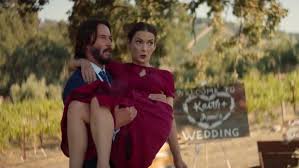 The cinematography is simple and straight on as though you WERE watching a play, with the beautiful setting of San Luis Obispo California, wine country, as merely a frame to this clever little romantic snapshot. It was shot in 10 days with no close-ups and few if any retakes.
The cinematography is simple and straight on as though you WERE watching a play, with the beautiful setting of San Luis Obispo California, wine country, as merely a frame to this clever little romantic snapshot. It was shot in 10 days with no close-ups and few if any retakes.
 Along with the casting of these two who have been friends since the 1980’s, there are a couple of other in-“jokes” as well. Lindsey suggests they play “Devil’s Advocate” in a discussion of their future as a couple, an offhand allusion to the movie The Devil’s Advocate in which Keanu Reeves starred. Frank alludes to his father’s new girlfriend as, “Being a senior while he [the father]was a freshman,” which is pointedly similar to a quote by Reeves’ character’s best friend, in
Along with the casting of these two who have been friends since the 1980’s, there are a couple of other in-“jokes” as well. Lindsey suggests they play “Devil’s Advocate” in a discussion of their future as a couple, an offhand allusion to the movie The Devil’s Advocate in which Keanu Reeves starred. Frank alludes to his father’s new girlfriend as, “Being a senior while he [the father]was a freshman,” which is pointedly similar to a quote by Reeves’ character’s best friend, in  Bill and Ted’s Excellent Adventure, when Ted refers to Reeves’ character Bill’s very young stepmom.
Bill and Ted’s Excellent Adventure, when Ted refers to Reeves’ character Bill’s very young stepmom.
Also, as an interesting side trivia, like their characters, though having been in serious relationships before, neither of the actors have ever been married. In addition, there’s a running cinema legend that the two actors have actually been married to each other for 25 years, having appeared in Francis Ford Coppola’s 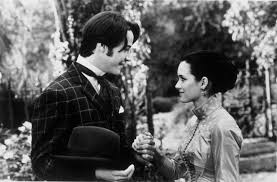 Dracula during which a real Romanian priest was engaged for the wedding ceremony of their characters.
Dracula during which a real Romanian priest was engaged for the wedding ceremony of their characters.
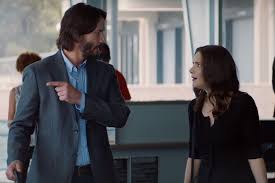 This is a movie for adults only, for language, conversation subject content, and a graphic scene of sexual activity. Although no skin is ever seen the clothed behavior is vivid and explicit although genuinely funny in its very artlessness.
This is a movie for adults only, for language, conversation subject content, and a graphic scene of sexual activity. Although no skin is ever seen the clothed behavior is vivid and explicit although genuinely funny in its very artlessness.
So if you are an adult in the mood for an individually peculiar, romantic comedy of two broken people searching for their complementary parts, you could do worse than follow Lindsay and Frank as they literally and figuratively go off the beaten track to find their awkward match.
And — welcome back to your rightful home in comedy Mr. Reeves!
AD ASTRA – A VERY DIFFERENT KIND OF SCI FI
SHORT TAKE:
Journey by a son in search of his father, set in space.
WHO SHOULD GO:
Older teens minimum for some language but mostly scenes of violence and the resulting dangers one might expect in tackling hard space. There is no sexual content.
LONG TAKE:
 Ad Astra (meaning “to the stars”) directed by James Gray, one of the writers, is a very interesting movie but not about what you might think. Ad Astra could have taken place as a western, underwater, in a haunted abandoned funhouse, a post-apocalyptic wasteland, in any normal day of a big city, or climbing a mountain. The writers James Gray and Ethan Gross chose to place this well told story in space and it is as good a backdrop as any of the others would have been. Combining allegory with pragmatic and brutal realism, Ad Astra plays out more like the Greek epic of discovery, The Odyssey or the Christian parable Pilgrim’s Progress, than a conventional science fiction story.
Ad Astra (meaning “to the stars”) directed by James Gray, one of the writers, is a very interesting movie but not about what you might think. Ad Astra could have taken place as a western, underwater, in a haunted abandoned funhouse, a post-apocalyptic wasteland, in any normal day of a big city, or climbing a mountain. The writers James Gray and Ethan Gross chose to place this well told story in space and it is as good a backdrop as any of the others would have been. Combining allegory with pragmatic and brutal realism, Ad Astra plays out more like the Greek epic of discovery, The Odyssey or the Christian parable Pilgrim’s Progress, than a conventional science fiction story. 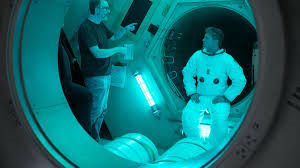 Gray, writer/director, himself has compared his story to Conrad’s Heart of Darkness.
Gray, writer/director, himself has compared his story to Conrad’s Heart of Darkness.
SPOILERS – BUT MINOR AND OBLIQUELY AS I CAN
The story is about Roy McBride, a top-flight astronaut, played by Brad Pitt (most recently in the wonderful role of a protective stuntman in Once Upon a Time in Hollywood), whose father, Clifford, disappeared 16 years before. 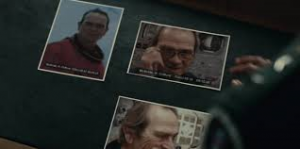 Roy’s father played by Tommy Lee Jones (Men in Black, The Fugitive, Captain America) is a brilliant scientist who went in search of evidence of extraterrestrial intelligence, then fell off the radar after leaving Saturn.
Roy’s father played by Tommy Lee Jones (Men in Black, The Fugitive, Captain America) is a brilliant scientist who went in search of evidence of extraterrestrial intelligence, then fell off the radar after leaving Saturn.
A series of catastrophic electronic storms have recently begun to devastate Earth. The Surges, as they are referred to, seem to be emanating from Neptune, and are suspected to be linked to Clifford’s disappearance. Roy is sent out to investigate with his father’s old partner, Thomas Pruitt, 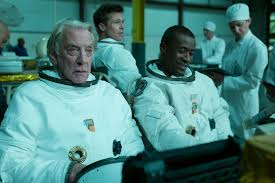 played by acting veteran Donald Sutherland.
played by acting veteran Donald Sutherland.
As an aside, I am a big fan of Donald Sutherland. Sutherland’s career dates back almost six decades. Playing opposite the likes of Robert Duvall, Helen Mirren, Orson Welles, Gene Wilder, and Julie Christie, his career includes an incredibly eclectic collection of almost two hundred entries, ranging from comic to horror to personal drama. His resume includes everything from classics like Hamlet and  Pride and Prejudice, to monster movies like the bad Dr. Terror’s House of Horrors and the brilliant
Pride and Prejudice, to monster movies like the bad Dr. Terror’s House of Horrors and the brilliant 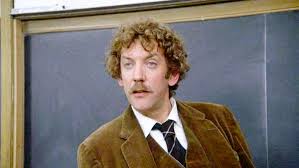 Invasion of the Body Snatchers, military black comedies like
Invasion of the Body Snatchers, military black comedies like  M.A.S.H. and
M.A.S.H. and 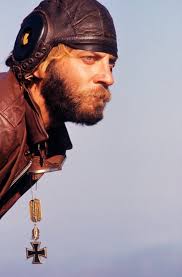 Kelly’s Heroes, deeply emotional personal dramas like
Kelly’s Heroes, deeply emotional personal dramas like 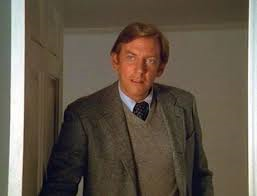 Ordinary People, the modern dystopian franchise
Ordinary People, the modern dystopian franchise 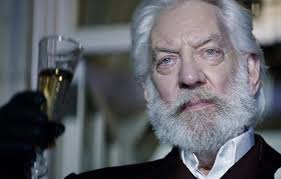 The Hunger Games, screwball comedies like
The Hunger Games, screwball comedies like 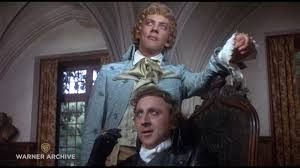 Start The Revolution Without Me, straight war movies like
Start The Revolution Without Me, straight war movies like 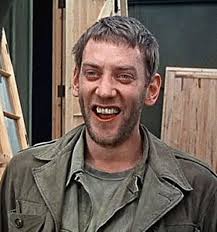 The Dirty Dozen and Eye of The Needle, and avant garde suspense like Don’t Look Now – the list goes on and on, and it was a pleasure to see him again even in a small character part.
The Dirty Dozen and Eye of The Needle, and avant garde suspense like Don’t Look Now – the list goes on and on, and it was a pleasure to see him again even in a small character part.
Rounding out the cast is 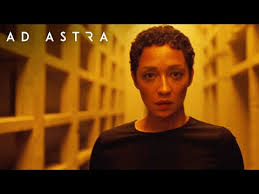 Ruth Negga (the prickly – in more ways than one – antagonist in Agents of S.H.I.E.L.D.) as Helen Santos, an ally who appears, like a messenger from a Greek myth, to provide Roy information he needs to urge him along his quest. Another character who hands Roy along like a baton is Colonel Levant played by Sean Blakemore.
Ruth Negga (the prickly – in more ways than one – antagonist in Agents of S.H.I.E.L.D.) as Helen Santos, an ally who appears, like a messenger from a Greek myth, to provide Roy information he needs to urge him along his quest. Another character who hands Roy along like a baton is Colonel Levant played by Sean Blakemore. 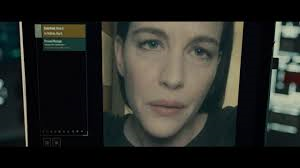 Liv Tyler (Lord of the Rings, Armageddon – so not Tyler’s first rodeo as a character enamored of a space cowboy) is Eve (to Roy’s Adam? – perhaps representing all mankind and their errors) the girl Roy leaves behind as Roy seems compelled as a lemming, without his father’s guidance, to repeat his father’s mistakes.
Liv Tyler (Lord of the Rings, Armageddon – so not Tyler’s first rodeo as a character enamored of a space cowboy) is Eve (to Roy’s Adam? – perhaps representing all mankind and their errors) the girl Roy leaves behind as Roy seems compelled as a lemming, without his father’s guidance, to repeat his father’s mistakes.
 However, Ad Astra is not really about the search for Roy’s father, but ultimately an insightful, honest and frank inner journey undertaken by Roy to conquer the demons left behind by Clifford’s abandonment of Roy’s family.
However, Ad Astra is not really about the search for Roy’s father, but ultimately an insightful, honest and frank inner journey undertaken by Roy to conquer the demons left behind by Clifford’s abandonment of Roy’s family.
Modern culture tries to expunge the need for a father in the home. Ad Astra highlights, at least in part, the fallacy of this destructive philosophy.
 The tone of the film reminds me of, and owes a lot to, Stanley Kubrick’s groundbreaking but ethereally distant 2001: A Space Odyssey, which created a mythology about mankind’s leaps of progress. In contrast, Ad Astra is relatable, in that it is told from the intimate point of view of one man’s personal evolution. The pace of Ad Astra is very slow and deliberate, arguably even sometimes dull. But such adagio of movement is necessary for the contemplatively atmosphere necessary for this pensive tale.
The tone of the film reminds me of, and owes a lot to, Stanley Kubrick’s groundbreaking but ethereally distant 2001: A Space Odyssey, which created a mythology about mankind’s leaps of progress. In contrast, Ad Astra is relatable, in that it is told from the intimate point of view of one man’s personal evolution. The pace of Ad Astra is very slow and deliberate, arguably even sometimes dull. But such adagio of movement is necessary for the contemplatively atmosphere necessary for this pensive tale.
 The events that transpire during the course of the film are anything but boring. The theme of obstacles structure the story and manifest in every way you can imagine: verbal, bureaucratic, intentionally hostile, the indifference of nature, clandestine, emotional, instinctive brutality, and the simple fact of the mind-numbingly immense distances required to complete Roy’s journey.
The events that transpire during the course of the film are anything but boring. The theme of obstacles structure the story and manifest in every way you can imagine: verbal, bureaucratic, intentionally hostile, the indifference of nature, clandestine, emotional, instinctive brutality, and the simple fact of the mind-numbingly immense distances required to complete Roy’s journey.
 The cinematography is magnificent. The depiction of the outer planets is stunning and awe-inspiring and brilliantly conveys the overwhelming majestic size of space itself, underscoring the enormity of the pilgrimage that Roy undertakes.
The cinematography is magnificent. The depiction of the outer planets is stunning and awe-inspiring and brilliantly conveys the overwhelming majestic size of space itself, underscoring the enormity of the pilgrimage that Roy undertakes.
 And pilgrimage Roy’s trip truly is. A pilgrimage of discovery. The pilgrim nature of Roy’s quest is underscored by the occasional but respectful and deliberate references to traditional Christian theology and belief. The spiritual nature of Roy’s expedition is also demonstrated by the way the writers strip Roy, piece by piece, of his armor plating – literally and figuratively, physically and emotionally – until he must confront his destiny as any questing knight must – face to face and alone. Roy’s progress is cleverly documented by way of periodic psychological tests he must take and pass in order to continue his journey. This serves as both a practical plot device as well as a metaphysical manifestation of Roy’s inner progress.
And pilgrimage Roy’s trip truly is. A pilgrimage of discovery. The pilgrim nature of Roy’s quest is underscored by the occasional but respectful and deliberate references to traditional Christian theology and belief. The spiritual nature of Roy’s expedition is also demonstrated by the way the writers strip Roy, piece by piece, of his armor plating – literally and figuratively, physically and emotionally – until he must confront his destiny as any questing knight must – face to face and alone. Roy’s progress is cleverly documented by way of periodic psychological tests he must take and pass in order to continue his journey. This serves as both a practical plot device as well as a metaphysical manifestation of Roy’s inner progress.
 The music by Max Richter is both triumphal and eerily beautiful, contributing to the contemplative feel of this mystery.
The music by Max Richter is both triumphal and eerily beautiful, contributing to the contemplative feel of this mystery.
 Ad Astra is not for everyone. It’s not properly a science fiction story, though it is set in a pragmatic future vision of human-conquering space. But it is far more violent than the average audience for a movie which primarily deals with inner analysis.
Ad Astra is not for everyone. It’s not properly a science fiction story, though it is set in a pragmatic future vision of human-conquering space. But it is far more violent than the average audience for a movie which primarily deals with inner analysis.
So go see Ad Astra if you are of the right age and want to see a thoughtful, meditative but dangerous odyssey. But go without any preconceived notions, for it is not the kind of science fiction movie you might expect, but approach it as you might a friend mulling over a retreat inspired epiphany which he wants to share.
NOISES OFF – BRILLIANT MADCAP COMEDY ON STAGE AT LCLT
SHORT TAKE:
Inventively staged, skillfully acted, and adroitly directed British comedy, the classic Noises Off by Michael Frayn, a play within a play at Lake Charles Little Theatre, showing from September 13 through September 29, 2019. GET YOUR TICKETS HERE!
WHO SHOULD GO:
Mid to upper teens and older for mildly sexual topics done in (almost) completely innocent fun. Nothing is shown and language is very mild. Younger than mid-teens should be parentally previewed and depend upon the child.
LONG TAKE:
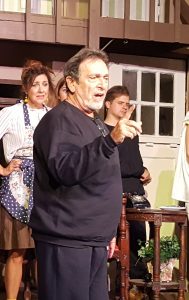 Move over James Brown. The hardest working people in show business are the actors performing Noises Off at The Lake Charles Little Theatre from Friday night September 13 through Sunday matinee September 29, 2019.
Move over James Brown. The hardest working people in show business are the actors performing Noises Off at The Lake Charles Little Theatre from Friday night September 13 through Sunday matinee September 29, 2019.
 I’m going to try hard not to give anything away because you need to see this fast paced, clever and hilarious play with the fresh eyes this dynamic and brilliant cast, crew and director deserve to get.
I’m going to try hard not to give anything away because you need to see this fast paced, clever and hilarious play with the fresh eyes this dynamic and brilliant cast, crew and director deserve to get.  Not only is there a lot going on but this is the kind of play which is so funny and well written, and this version so energetic and professionally conceived, you’ll want to see it more than once.
Not only is there a lot going on but this is the kind of play which is so funny and well written, and this version so energetic and professionally conceived, you’ll want to see it more than once.  I saw Noises Off on stage years ago and the movie with Michael Caine several times but familiarity only made this witty badinage funnier and this iteration had me laughing from curtain up to curtain call.
I saw Noises Off on stage years ago and the movie with Michael Caine several times but familiarity only made this witty badinage funnier and this iteration had me laughing from curtain up to curtain call.
 The set is incredible – probably the most challenging I have ever seen at LCLT – and I can’t think of a soul in the world I would have trusted more to build it than LCLT’s own Randy Partin. Built by Mr. Partin in 110 hours over six weeks as a labor of devotion to this Theatre, it is one of, if not THE most ambitious sets LCLT has ever used.
The set is incredible – probably the most challenging I have ever seen at LCLT – and I can’t think of a soul in the world I would have trusted more to build it than LCLT’s own Randy Partin. Built by Mr. Partin in 110 hours over six weeks as a labor of devotion to this Theatre, it is one of, if not THE most ambitious sets LCLT has ever used.  Seven (or eight depending how you define them) crucial entrance/exit portals in a two story parlor of a large off season bed and breakfast provides the setting of this raucous comedy as an ensemble cast rehearse and perform the first act of a British sex farce called Nothing On – a play within the play. The set is as much of a character as the performers.
Seven (or eight depending how you define them) crucial entrance/exit portals in a two story parlor of a large off season bed and breakfast provides the setting of this raucous comedy as an ensemble cast rehearse and perform the first act of a British sex farce called Nothing On – a play within the play. The set is as much of a character as the performers.
 As though channeling Led Zepplin’s “Stairway to Heaven” or Ike and Tina Turner’s “Proud Mary”, Noises Off begins gently – or I should say with that certain inherent gentility of an innately British parlor comedy – as the characters and their quirks are introduced.
As though channeling Led Zepplin’s “Stairway to Heaven” or Ike and Tina Turner’s “Proud Mary”, Noises Off begins gently – or I should say with that certain inherent gentility of an innately British parlor comedy – as the characters and their quirks are introduced.  Then slowly the action builds over three acts to Mad Mad World levels of freneticism as tempers flare,
Then slowly the action builds over three acts to Mad Mad World levels of freneticism as tempers flare,  sleepless nights take their toll, personalities clash, and jealousies rage amidst the over worked, under prepared thespians, who desperately struggle to make some sense of a timing-crucial confusing play and their own even more befuddled love lives.
sleepless nights take their toll, personalities clash, and jealousies rage amidst the over worked, under prepared thespians, who desperately struggle to make some sense of a timing-crucial confusing play and their own even more befuddled love lives. 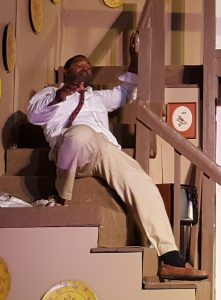 A tagline I once read sums it up nicely: “The drama! The suspense! And the curtain hasn’t even gone up yet!”
A tagline I once read sums it up nicely: “The drama! The suspense! And the curtain hasn’t even gone up yet!”
 It takes a truly brilliant actor to play the fool – Jerry Lewis, the stooge and buffoon on stage and screen, was actually the brains and organizer of the Lewis-Martin team. Stan Laurel, on film and in vaudeville the ever whining, clueless whipping boy for Oliver Hardy was, in truth, the author of most of the routines and genius behind their success.
It takes a truly brilliant actor to play the fool – Jerry Lewis, the stooge and buffoon on stage and screen, was actually the brains and organizer of the Lewis-Martin team. Stan Laurel, on film and in vaudeville the ever whining, clueless whipping boy for Oliver Hardy was, in truth, the author of most of the routines and genius behind their success.  Similarly, it takes virtuoso coordination and intricately planned team effort to appear to get wrong a play which, itself, is suppose to require flawless timing.
Similarly, it takes virtuoso coordination and intricately planned team effort to appear to get wrong a play which, itself, is suppose to require flawless timing.
The clockwork details require talented hands and this brilliant LCLT troupe manuever like the Blue Angels on stage with, collectively, over a hundred years of tenured experience amongst them. You will recognize most, if not all, of the performers.
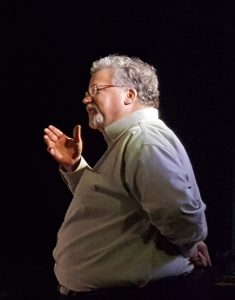 Brett Downer is the brave soul who directed this enormously challenging Russian nesting doll of a play which relies on timing, entrances, exits, and … sardines.
Brett Downer is the brave soul who directed this enormously challenging Russian nesting doll of a play which relies on timing, entrances, exits, and … sardines.
 Heather Partin is Belinda/Flavia, the mediator of the beleaguered troupe. If you have EVER been to LCLT or a community band concert you will likely have seen Heather.
Heather Partin is Belinda/Flavia, the mediator of the beleaguered troupe. If you have EVER been to LCLT or a community band concert you will likely have seen Heather.  Her resume is impressive, ranging from Nunsense to MacBeth, devoted wife of Randy, and costume designer for the show.
Her resume is impressive, ranging from Nunsense to MacBeth, devoted wife of Randy, and costume designer for the show.
 Paula McCain, most recently from Mamma Mia! but debuting with LCLT here, she plays Dotty/Mrs. Clackett,
Paula McCain, most recently from Mamma Mia! but debuting with LCLT here, she plays Dotty/Mrs. Clackett,  financially desperate for Nothing On to succeed and the center about which much of the interpersonal friction is created amongst the cast.
financially desperate for Nothing On to succeed and the center about which much of the interpersonal friction is created amongst the cast.
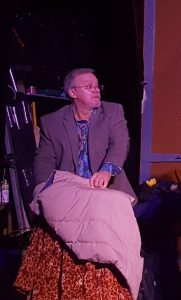 Greg Stratton, playing to type, is Lloyd, the director of this play within the play, who is part teacher/father-figure, part chaos instigator, whose mind isn’t always on the job at hand.
Greg Stratton, playing to type, is Lloyd, the director of this play within the play, who is part teacher/father-figure, part chaos instigator, whose mind isn’t always on the job at hand.  Greg teaches Mass Com at McNeese, has been acting and directing for decades from the nostalgic comedy Laughter on the 23rd Floor to the tongue-in-cheek mystery The 39 Steps.
Greg teaches Mass Com at McNeese, has been acting and directing for decades from the nostalgic comedy Laughter on the 23rd Floor to the tongue-in-cheek mystery The 39 Steps.
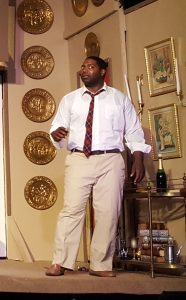 The loveable and reliable but hopelessly insecure Garry/Roger is played by Michael Davis,
The loveable and reliable but hopelessly insecure Garry/Roger is played by Michael Davis,  a singer, actor, dancer and video producer, most recently in LCLT’s Pump Boys and Dinettes.
a singer, actor, dancer and video producer, most recently in LCLT’s Pump Boys and Dinettes.
 Rebecca Harris, having sparkled in ACTS Theatre’s Arsenic and Old Lace,
Rebecca Harris, having sparkled in ACTS Theatre’s Arsenic and Old Lace,  is sweetly ditzy Brooke/Vicki who soldiers on no matter the obstacles in her own guileless way.
is sweetly ditzy Brooke/Vicki who soldiers on no matter the obstacles in her own guileless way.
 Angela Martin debuts with Lake Charles Little Theatre as Poppy, the devoted but under appreciated, both on and off stage, assistant stage manager.
Angela Martin debuts with Lake Charles Little Theatre as Poppy, the devoted but under appreciated, both on and off stage, assistant stage manager. 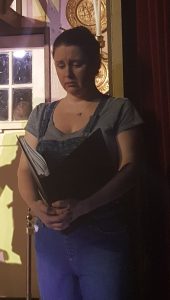 While debuting here in her first speaking part Ms. Martin nonetheless has an impressive set of credentials which include a stint with London’s West End! not to mention being married to castmate Cary Martin.
While debuting here in her first speaking part Ms. Martin nonetheless has an impressive set of credentials which include a stint with London’s West End! not to mention being married to castmate Cary Martin.
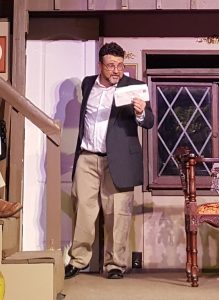 Cary Martin is our own prodigal son, last at LCLT 20 years ago, but returning to the fold as Frederick/Philip,
Cary Martin is our own prodigal son, last at LCLT 20 years ago, but returning to the fold as Frederick/Philip, 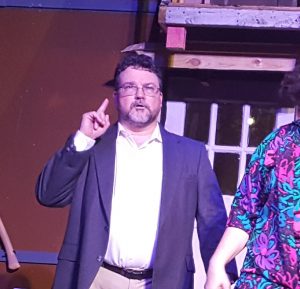 a well-meaning but daft and perpetually confused soul.
a well-meaning but daft and perpetually confused soul.
 Cameron Scallon, veteran of LCLT and lately one of the leads in Bye Bye Birdie, plays Tim, of necessity the resident Jack of all trades, the
Cameron Scallon, veteran of LCLT and lately one of the leads in Bye Bye Birdie, plays Tim, of necessity the resident Jack of all trades, the  exhausted and threadbare stage manager, who is constantly plugging up holes in this leaking levee with not enough fingers to go around.
exhausted and threadbare stage manager, who is constantly plugging up holes in this leaking levee with not enough fingers to go around.
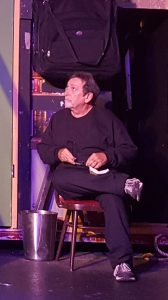 Gary Shannon on stage is the amiable but constantly drunken Selsdon/Burglar and in real life is the morning drive show radio host for KHLA, host of KBYS’ Sunday morning Jazz Show, long time veteran of community theater and independent film makers here in Lake Charles,
Gary Shannon on stage is the amiable but constantly drunken Selsdon/Burglar and in real life is the morning drive show radio host for KHLA, host of KBYS’ Sunday morning Jazz Show, long time veteran of community theater and independent film makers here in Lake Charles,  and who some years ago, I saw perform an amazing Willie Loman from Death of a Salesman with only a scant few weeks preparation.
and who some years ago, I saw perform an amazing Willie Loman from Death of a Salesman with only a scant few weeks preparation.
Accessories to the insanity are: James Johnson as set decorator, Dan Sadler as Technical Consultant, Jonathan in lighting, David Wynn from KBYS for sound, and Liz Trahan who was kind enough to put together the ingeniously crafted program.
 Aaaaaaaaaaand not to discourage audience members from either buying concessions or hitting the “loo” but you’ll really want to stay for at least part of the scene changes during intermission.
Aaaaaaaaaaand not to discourage audience members from either buying concessions or hitting the “loo” but you’ll really want to stay for at least part of the scene changes during intermission.
 So for the most fun you’ll have this side of your best friend’s wedding, go see Noises Off at Lake Charles Little Theatre.
So for the most fun you’ll have this side of your best friend’s wedding, go see Noises Off at Lake Charles Little Theatre.  You can CALL 337433-7988, buy tickets at the door or get them HERE. And plan to go early in the run the first time, as you’ll likely want to see it again.
You can CALL 337433-7988, buy tickets at the door or get them HERE. And plan to go early in the run the first time, as you’ll likely want to see it again.
{NOTE: In an effort not to spoil the show I’m holding off on some of the photos, but will release them all after the run of the show.}
ODE TO JOY – LOVE STORY WITH A TWIST
AUDIO PODCAST OPTION OF “ODE TO JOY – LOVE STORY WITH A TWIST” REVIEW
SHORT TAKE:
How do you manage a romance if being happy makes you pass out? This is the conundrum with which a cataplexic man struggles when his perfect woman unexpectedly appears.
WHO SHOULD WATCH:
Mature older teens and up for language, comedic miming of sex, and attempts by the main characters to physical intimacy, though there is no nudity or anything graphic.
LONG TAKE:
What do Sherlock, Deadpool, Big Bang Theory, Saturday Night Live and a Bob Fosse docudrama have in common? The best of the supporting cast of each of these film projects in an adorable little rom com, directed by Jason Winer and written by Max Werner and Chris Higgins called Ode to Joy.
A friend of mine has often teased that EVERY movie could be described as “a love story with a twist”. But Ode to Joy really is.
SPOILERS
 Martin Freeman, (Watson from Sherlock) is Charlie, a man who suffers from a neurologic condition called cataplexy, a condition in which any strong emotion, but for him especially joy and happiness, will cause him to — basically faint. Watching a cute cat video could render him unceremoniously unconscious, and while it may initially seem funny, the movie points out how dangerous, both physically and emotionally, the condition can be for those who actually suffer from this condition.
Martin Freeman, (Watson from Sherlock) is Charlie, a man who suffers from a neurologic condition called cataplexy, a condition in which any strong emotion, but for him especially joy and happiness, will cause him to — basically faint. Watching a cute cat video could render him unceremoniously unconscious, and while it may initially seem funny, the movie points out how dangerous, both physically and emotionally, the condition can be for those who actually suffer from this condition. 
The script is based upon a radio interview (which you can listen to HERE) with a man named Matt Frerkin, himself a neuroscientist, who discovered he had this condition after becoming unable to move whenever he experiences strong emotion.
So Charlie keeps himself in constant emotional check, leading a quiet life as a librarian — until the girl of his dreams storms in.
 Jake Lacy (featured as Gwen Verdon’s second string love interest in the mini-series about the life of Bob Fosse and Gwen Verdon, Fosse/Verdon) plays Cooper, his watchful but fun love ‘em and leave ‘em brother.
Jake Lacy (featured as Gwen Verdon’s second string love interest in the mini-series about the life of Bob Fosse and Gwen Verdon, Fosse/Verdon) plays Cooper, his watchful but fun love ‘em and leave ‘em brother.
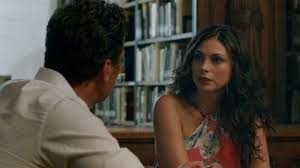 Morena Baccarin (Deadpool’s fiancee) is Francesca, the woman who breaks into Charlie’s well encapsulated life.
Morena Baccarin (Deadpool’s fiancee) is Francesca, the woman who breaks into Charlie’s well encapsulated life.
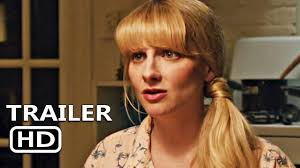 Melissa Rauch (the loud but loveable Bernadette from The Big Bang Theory) is Bethany, a mousy eccentric woman, who rounds out the quartet.
Melissa Rauch (the loud but loveable Bernadette from The Big Bang Theory) is Bethany, a mousy eccentric woman, who rounds out the quartet.
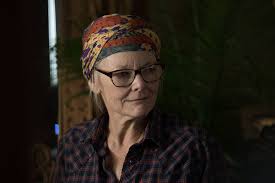 Jane Curtain (an SNL charter member) is Francesca’s Aunt Sylvia, who is full of life despite her terminal illness.
Jane Curtain (an SNL charter member) is Francesca’s Aunt Sylvia, who is full of life despite her terminal illness.
There’s more than meets the eye to this un petite affaire de coeur. 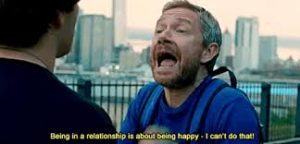 At one point Charlie yells at his brother, plaintively wondering if he understands what it is like to live every day afraid of making a fool of yourself. The answer is, of course, yes. Everyone does. We all have our burdens to bear. And when anyone falls in love, as Charlie has, they expose themselves to the ultimate vulnerabilities. It doesn’t take cataplexy to make you aware of the potential hurt and humiliation, rejection and risk of falling – in Charlie’s case literally – head over heels. Charlie’s cataplexy is merely an extreme physical manifestation of the chance we all take with that bold step out to admit we love.
At one point Charlie yells at his brother, plaintively wondering if he understands what it is like to live every day afraid of making a fool of yourself. The answer is, of course, yes. Everyone does. We all have our burdens to bear. And when anyone falls in love, as Charlie has, they expose themselves to the ultimate vulnerabilities. It doesn’t take cataplexy to make you aware of the potential hurt and humiliation, rejection and risk of falling – in Charlie’s case literally – head over heels. Charlie’s cataplexy is merely an extreme physical manifestation of the chance we all take with that bold step out to admit we love.
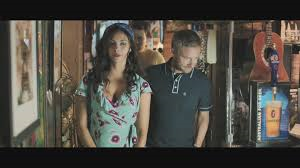 What can leave us more exposed than being unconscious, especially unbidden and unexpectedly? And that is a perfect analogy for the leap you must take in a commitment. You lay your life, your heart and your unconditional willingness to accept rejection out on the floor, undefended to whatever might happen beyond your control. God, Himself, takes that risk with every human’s Free Will when He offers us Grace and unconditional Divine Love. Though there are consequences to turning our back on this Love, God never ceases to offer that Love. And ultimately this is what Charlie realizes he must do to pursue the good of another – genuine Love, Love without a sense of entitlement, what Plato would call philia born of eros, or a Catholic might call Charity – in order to find true — Joy.
What can leave us more exposed than being unconscious, especially unbidden and unexpectedly? And that is a perfect analogy for the leap you must take in a commitment. You lay your life, your heart and your unconditional willingness to accept rejection out on the floor, undefended to whatever might happen beyond your control. God, Himself, takes that risk with every human’s Free Will when He offers us Grace and unconditional Divine Love. Though there are consequences to turning our back on this Love, God never ceases to offer that Love. And ultimately this is what Charlie realizes he must do to pursue the good of another – genuine Love, Love without a sense of entitlement, what Plato would call philia born of eros, or a Catholic might call Charity – in order to find true — Joy.
 There are scenes in which Charlie experiences true Joy, but is not “Happy” in the emotionally excited way which most of us think of as “happy” or which would trigger his cataplexy. Charlie, during these scenes, is noticeably joyful, pointed out by the other characters, even while we the audience members know he is sad, as Charlie attempts to bring Joy into the life of someone else even at his own expense.
There are scenes in which Charlie experiences true Joy, but is not “Happy” in the emotionally excited way which most of us think of as “happy” or which would trigger his cataplexy. Charlie, during these scenes, is noticeably joyful, pointed out by the other characters, even while we the audience members know he is sad, as Charlie attempts to bring Joy into the life of someone else even at his own expense.  He unwittingly discovers what is true Love, even though neither his friends or even Charlie really understands this.
He unwittingly discovers what is true Love, even though neither his friends or even Charlie really understands this.
As for Francesca, she is a woman who prefers to set herself up for romantic failure. Having lost her mother to hereditary breast cancer and on the verge of losing her beloved Aunt to the same disease, she tends to keep things superficial, moving frequently and choosing shallow men uninterested in a permanent relationship. 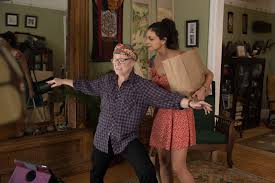 But Francesca too instinctively knows true Love and Joy as, though sad, she Joyfully visits and helps her Aunt, who she describes as her best friend. And counseled by her open-hearted, Bucket List accomplishing Aunt Sylvia, Francesca also wrestles with the idea of what it means to Love and commit.
But Francesca too instinctively knows true Love and Joy as, though sad, she Joyfully visits and helps her Aunt, who she describes as her best friend. And counseled by her open-hearted, Bucket List accomplishing Aunt Sylvia, Francesca also wrestles with the idea of what it means to Love and commit.
It occurred to me that the characters were what an adult version of Inside Out might look like from the mind of someone “in love” who matures from adolescent infatuation to true altruistic Love. 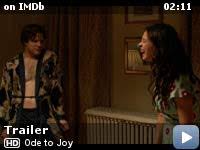 From Francesca’s often unfettered enthusiasm and Cooper’s libido, to Bethany’s confused obliviousness, Charlie’s hyper-awareness of his vulnerabilities, and finally the wisdom of Aunt Sylvia who, more than most, understands the ephemeral preciousness of life and the importance of altruistic Love, they rotate about each other examining the question of the importance of living well and FOR someone you love – even if you have to risk pain and loss.
From Francesca’s often unfettered enthusiasm and Cooper’s libido, to Bethany’s confused obliviousness, Charlie’s hyper-awareness of his vulnerabilities, and finally the wisdom of Aunt Sylvia who, more than most, understands the ephemeral preciousness of life and the importance of altruistic Love, they rotate about each other examining the question of the importance of living well and FOR someone you love – even if you have to risk pain and loss.
 The music by Jeremy Turner is simple, the cinematography by David Robert Jones uncomplicated, but the story is neither. Although Ode to Joy is in that familiar niche of quirky romantic comedies with some unique obstacle to the main couple’s happiness, Ode to Joy is also an intelligent and clever story which surprises, offering quite a bit to think about.
The music by Jeremy Turner is simple, the cinematography by David Robert Jones uncomplicated, but the story is neither. Although Ode to Joy is in that familiar niche of quirky romantic comedies with some unique obstacle to the main couple’s happiness, Ode to Joy is also an intelligent and clever story which surprises, offering quite a bit to think about.
The language is occasionally adult with completely unnecessary profanity. And two unmarried couples try to go to bed together, though no nudity and ultimately, and wisely, nothing happens because of — comic reasons.
 My only real complaint about the movie is it leaves the outcome of one of the characters unresolved and unaddressed, especially frustrating as that character was unfairly treated and earned a conclusion.
My only real complaint about the movie is it leaves the outcome of one of the characters unresolved and unaddressed, especially frustrating as that character was unfairly treated and earned a conclusion.
But overall Ode to Joy was – a joy to watch. So if you have a rainy afternoon to spend with someone you love, you could do worse than spend it watching and talking about this lovely little film with the big heart that is an Ode to Joy.
IT: CHAPTER TWO – BETTER THAN THE BOOK & MORE THAN I EXPECTED BUT PLEASE DO NOT TAKE CHILDREN
SHORT TAKE:
Surprisingly thoughtful, intricately plotted, well acted and very effective but terrifying finale to the film version of Stephen King’s mammoth-sized book IT.
WHO SHOULD GO:
I would like to make one thing clear: STEPHEN KING STORIES ARE NOT CHILD FRIENDLY!!!
There is a warning at the beginning of the movie which declares flashing lights could trigger epileptic seizures in the photosensitive. But that is the LEAST of the problems. There is also sexually discussed content, a profound amount of gratuitous profanity, some of it blasphemous, a lot of lethal violence and gore with child victims in close up, homicide, patricide, people being burned alive, grotesque deformities, slit throats, an explicit scene of suicide, overt physical and implied sexual abuse, and brief but conspicuous demonstrations of alternative sexuality. 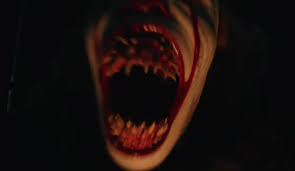 The violence and bloodshed would have alarmed the Grimm Brothers, though this is to be expected in any movie about a child-eating monster.
The violence and bloodshed would have alarmed the Grimm Brothers, though this is to be expected in any movie about a child-eating monster.
I do not know what the parents in the audience were thinking but there was a group of under-chaperoned young teens in the audience next to me for whom I cringed, given the film’s content as well as the visuals in some of the trailers. An R-rated movie will attract R-rated trailers, which R-rated “coming soon” offerings will not be R-rated “ONLY” for gore. One of the movies previewed at the afternoon showing of IT: C2, which was viewed by these kids, included scantily clad pole dancers! Even more inexplicable was the presence of young children who, predictably, begin to cry almost from the outset. Bringing kids to an R-rated movie of any kind, much less a horror fest, is a face-palming level of stupidity, bordering on child neglect, if not abuse.
Let me repeat KING IS NOT CHILD FRIENDLY. DO NOT TAKE CHILDREN.
FOR MATURE ADULT AGE TEENS AND UP ONLY!!!
LONG TAKE:
I walked into IT: Chapter Two fully expecting not to like it. I can hardly be blame. I didn’t like the book and although the TV version had a – dare I say it – certain charm due to the talents of Tim Curry as Pennywise the sinister, extraterrestrial psycho killer clown, and the recent Part 1, IT, wasn’t bad, I still did not hold out much for Part 2, having read the book. 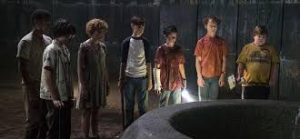 My youngest, now 21, pointed out an element that had not occurred to me about Part 1 – that instead of a straight up horror story it could be seen as an analogy for overcoming one’s childhood traumas and deepest wounds.
My youngest, now 21, pointed out an element that had not occurred to me about Part 1 – that instead of a straight up horror story it could be seen as an analogy for overcoming one’s childhood traumas and deepest wounds.
Although I thought this idea had merit I still dreaded what they would do with the second installment. After all it was based upon an excessively long, often deeply disturbing novel which catered to our darkest impulses and often relied heavily on caricature-level biases against small town citizens, authority figures, and parents.
 However, I was pleasantly surprised by the film. While it is, by no means, a great movie, it is far better than I thought it would be. IT: Chapter Two is the second half of Stephen King’s elephantine book IT about 7 children, outcasts in different ways, who bond as The Losers’ Club to fight an other worldly monster, and their adult selves who return 27 years later to kill IT. My review of the filmed version of the first half of the book – IT – is HERE and covers the child actor versions of the characters. The kids return in clips and flashbacks.
However, I was pleasantly surprised by the film. While it is, by no means, a great movie, it is far better than I thought it would be. IT: Chapter Two is the second half of Stephen King’s elephantine book IT about 7 children, outcasts in different ways, who bond as The Losers’ Club to fight an other worldly monster, and their adult selves who return 27 years later to kill IT. My review of the filmed version of the first half of the book – IT – is HERE and covers the child actor versions of the characters. The kids return in clips and flashbacks.
SPOILERS – BIG, CASUAL SPOILERS – SO BE FORWARNED
The adults include: 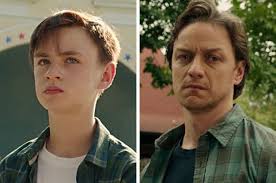 James McAvoy (whose incredibly varied resume includes: The Lion, The Witch and The Wardrobe, Split, Atomic Blonde, and the entire X-Men reboot series) is Bill, the stuttering leader of the group.
James McAvoy (whose incredibly varied resume includes: The Lion, The Witch and The Wardrobe, Split, Atomic Blonde, and the entire X-Men reboot series) is Bill, the stuttering leader of the group.  Jessica Chastain (Molly’s Game, Interstellar) is Beverly the grown up abused child who marries another abusive man.
Jessica Chastain (Molly’s Game, Interstellar) is Beverly the grown up abused child who marries another abusive man. 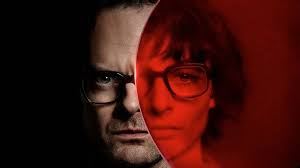 Bill Hader (who has done a lot of voice over acting) is Richie the comedian who as a child seems physically incapable of keeping his smart aleck bully-antagonizing comments to himself.
Bill Hader (who has done a lot of voice over acting) is Richie the comedian who as a child seems physically incapable of keeping his smart aleck bully-antagonizing comments to himself.  Isaiah Mufasa is Mike, as a child one of the only black people in Derry and an orphan whose parents burned to death in a tragedy he witnessed, and as an adult is the librarian and self appointed guardian of Derry who stays to watch for the monster’s re-appearance.
Isaiah Mufasa is Mike, as a child one of the only black people in Derry and an orphan whose parents burned to death in a tragedy he witnessed, and as an adult is the librarian and self appointed guardian of Derry who stays to watch for the monster’s re-appearance. 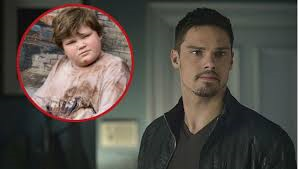 The significantly sleeker and athletic grown up Ben is played by born-Kiwi (native New Zealander) now Aussie Jay Ryan (who, in a note of incredible irony, before becoming established as an actor, used to perform in local supermarkets entertaining young children as —– a clown).
The significantly sleeker and athletic grown up Ben is played by born-Kiwi (native New Zealander) now Aussie Jay Ryan (who, in a note of incredible irony, before becoming established as an actor, used to perform in local supermarkets entertaining young children as —– a clown).  Andy Bean is the adult Stan whose Jewish faith, when a child in Derry, made him the target of abuse by the town bullies.
Andy Bean is the adult Stan whose Jewish faith, when a child in Derry, made him the target of abuse by the town bullies.  Finally, fatherless, hypochondriacal, mother-dominated Eddie has grown up to be played by James Ransone.
Finally, fatherless, hypochondriacal, mother-dominated Eddie has grown up to be played by James Ransone.
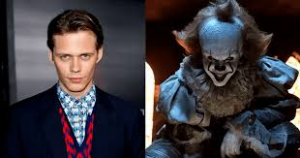 Bill Skarsgård (a worthy addition to the Skarsgard acting family which includes both brother Alexander from Melancholia, Battleship, and Tarzan, as well as his father Stellan from the Marvel movies) reprises his role as Pennywise.
Bill Skarsgård (a worthy addition to the Skarsgard acting family which includes both brother Alexander from Melancholia, Battleship, and Tarzan, as well as his father Stellan from the Marvel movies) reprises his role as Pennywise.  One might hate his performance as the psycho clown or be fascinated by his interpretation of King’s murderous mountebank,
One might hate his performance as the psycho clown or be fascinated by his interpretation of King’s murderous mountebank, 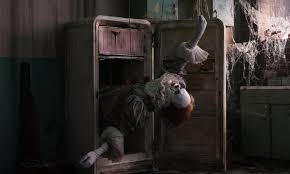 but no one can deny that Skarsgard puts his all into the character, going full out to invest Pennywise with as much horror as a harlequin can hold.
but no one can deny that Skarsgard puts his all into the character, going full out to invest Pennywise with as much horror as a harlequin can hold.
While Gary Dauberman, the scriptwriter, REALLY needs to learn the meaning of “less is more” (and yes, I know, people who live in glass houses….), he, with director Andy Muschietti, (whose only big credit up to now was another horror movie – Mama), made some VERY VERY good plot choices.
There were a number of circumstances in the source material they decided to leave out. Among the sensible deletions were, among a number of other smaller but improvement tweaks: Tom, Beverly’s abusive husband doesn’t pursue them into Pennywise’s lair in a last minute late third act conflict. 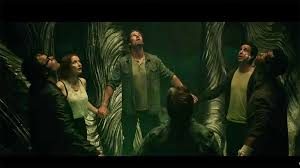 They do NOT use a parody-level, laughable, King-invented creation myth of a turtle who vomits up the universe to defeat Pennywise. Derry did not blow up when the monster died, resulting in the group being heroes who save a town leaving hope in their wake instead of monster hunters who leave nothing but destruction behind them. Bill’s wife, Audra, did not show up needing to be saved which would have further padded an already excessively long run time.
They do NOT use a parody-level, laughable, King-invented creation myth of a turtle who vomits up the universe to defeat Pennywise. Derry did not blow up when the monster died, resulting in the group being heroes who save a town leaving hope in their wake instead of monster hunters who leave nothing but destruction behind them. Bill’s wife, Audra, did not show up needing to be saved which would have further padded an already excessively long run time.  And they explicitly do NOT again lose their memories of Derry after the monster is vanquished, which retention implies they have learned to conquer their own inner demons as well as the extraterrestrial who externalized those fears. (NOT to mention the extremely wise excision in the first movie of the truly disturbed scene in the book where the boys “tag team” Beverly in a bonding ritual of intimacy.)
And they explicitly do NOT again lose their memories of Derry after the monster is vanquished, which retention implies they have learned to conquer their own inner demons as well as the extraterrestrial who externalized those fears. (NOT to mention the extremely wise excision in the first movie of the truly disturbed scene in the book where the boys “tag team” Beverly in a bonding ritual of intimacy.)
These cuts indicated a well considered re-evaluation of King’s original book.  Dauberman and Muschietti kept what made a good horror story from King’s book IT and replaced the book’s failings with plot and character structures that provided IT with a deeper, layered and even subtle meaning over which King’s far more negative paper prose had steam rollered. Thankfully, and in a rarity, the filmmakers had a bit more sense and gentler hand than did the initiating author.
Dauberman and Muschietti kept what made a good horror story from King’s book IT and replaced the book’s failings with plot and character structures that provided IT with a deeper, layered and even subtle meaning over which King’s far more negative paper prose had steam rollered. Thankfully, and in a rarity, the filmmakers had a bit more sense and gentler hand than did the initiating author.
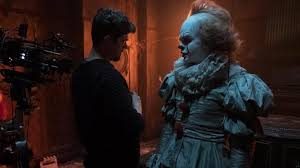 Dauberman also chose to craft the story around a continuation of the first film’s theme of conquering childhood fears. Each adult, who had formerly been a member of The Losers’ Club, contributes to the defeat of the fear-eating monster by facing and debriding some wound which fundamentally shaped their personalities.
Dauberman also chose to craft the story around a continuation of the first film’s theme of conquering childhood fears. Each adult, who had formerly been a member of The Losers’ Club, contributes to the defeat of the fear-eating monster by facing and debriding some wound which fundamentally shaped their personalities.  Bev once and for all denies her abusive father’s hold over her by embracing Ben’s unconditional genuine love for her. Ben, at one point, is trapped in their childhood underground clubhouse with its walls closing in on him, physicalizing how he was trapped in the fat of his own prepubescent body, but vanquishes this self-killing insecurity by declaring his love for Beverly in acknowledgment that he is not alone and is worthy of loving and being loved.
Bev once and for all denies her abusive father’s hold over her by embracing Ben’s unconditional genuine love for her. Ben, at one point, is trapped in their childhood underground clubhouse with its walls closing in on him, physicalizing how he was trapped in the fat of his own prepubescent body, but vanquishes this self-killing insecurity by declaring his love for Beverly in acknowledgment that he is not alone and is worthy of loving and being loved. 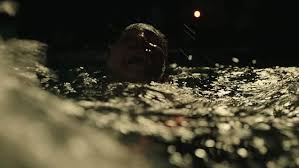 Bill almost drowns in the same sewer water in which his brother Georgie died, then kills a younger self-accusatory version of himself, finally putting his misplaced guilt over his brother’s death behind him. Eddie uncovers Pennywise’s fatal weakness when he throws off his germophobia long enough to successfully wrestle a leperous manifestation of the evil clown.
Bill almost drowns in the same sewer water in which his brother Georgie died, then kills a younger self-accusatory version of himself, finally putting his misplaced guilt over his brother’s death behind him. Eddie uncovers Pennywise’s fatal weakness when he throws off his germophobia long enough to successfully wrestle a leperous manifestation of the evil clown.
And so it goes. As each member adds to the pot the Losers get stronger.
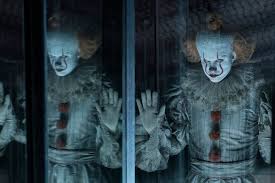 To defeat Pennywise they must all reduce him to a killable size. Metaphorically this makes perfect sense. One’s childhood fears can seem to increase proportionately as one gets older, towering over us unchecked and unconfronted to destroy us.
To defeat Pennywise they must all reduce him to a killable size. Metaphorically this makes perfect sense. One’s childhood fears can seem to increase proportionately as one gets older, towering over us unchecked and unconfronted to destroy us. 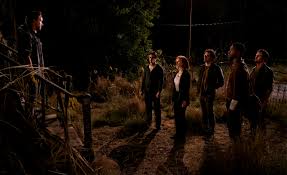 But in the light of mature perspective, trauma can be reduced to manageable size from which one can learn, grow, and even benefit. This is a philosophy worth considering and manifests in a monstrously (if you’ll excuse the pun) dramatic way in Pennywise.
But in the light of mature perspective, trauma can be reduced to manageable size from which one can learn, grow, and even benefit. This is a philosophy worth considering and manifests in a monstrously (if you’ll excuse the pun) dramatic way in Pennywise.
There are also a couple of fun cameos – Stephen King, himself, as an opportunistic second-hand shop owner, and  Peter Bogdanovich (real life director of Noises Off, Paper Moon, and What’s Up Doc?) playing to type as a film director.
Peter Bogdanovich (real life director of Noises Off, Paper Moon, and What’s Up Doc?) playing to type as a film director.
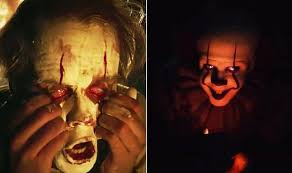 BUT for all of its successes as a horror film – IT is WAY too long – by about a third. Just having to accommodate a large ensemble cast will make for an inherently long story. Accommodating TWO ensemble groups – with present-time adults and childhood dove-tailing flashbacks – is one of the reasons this movie is almost a full 3 hours long. Its padding is mostly due to not trusting the average ticket buyers. Dauberman, et al, needn’t have worried that audience members would RANDOMLY wander into a movie house showing a movie titled IT: Chapter Two. We really did not need all the backtracking, and re-covering old childhood ground with “new” adult eyes to understand what was going on.
BUT for all of its successes as a horror film – IT is WAY too long – by about a third. Just having to accommodate a large ensemble cast will make for an inherently long story. Accommodating TWO ensemble groups – with present-time adults and childhood dove-tailing flashbacks – is one of the reasons this movie is almost a full 3 hours long. Its padding is mostly due to not trusting the average ticket buyers. Dauberman, et al, needn’t have worried that audience members would RANDOMLY wander into a movie house showing a movie titled IT: Chapter Two. We really did not need all the backtracking, and re-covering old childhood ground with “new” adult eyes to understand what was going on.
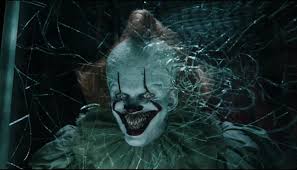 In addition, I do not think they understood the difference between pausing long enough for tension to build and holding on to the “punch line” so long you start checking your watch. There are a LOT of jump scares in IT. This movie practically parkours its way through the entire plot on jump scares. And every SINGLE jump scare endures a prolonged preview. For example,
In addition, I do not think they understood the difference between pausing long enough for tension to build and holding on to the “punch line” so long you start checking your watch. There are a LOT of jump scares in IT. This movie practically parkours its way through the entire plot on jump scares. And every SINGLE jump scare endures a prolonged preview. For example, 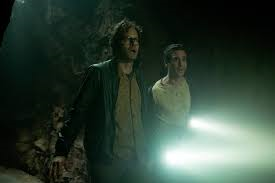 Rich and Eddie encounter a cute Pomeranian dog – probably because Rich had jokingly stated a wish that he hoped the monster’s true form would be in this shape. We all know the dog is going to jump scare into a monster-size zombie dog but far too many beats go by as Rich and Eddie comment about how cute it is before this happens. So, yeah, about an hour could have been chopped just by jumping, instead of dragging, their way to the jump scares.
Rich and Eddie encounter a cute Pomeranian dog – probably because Rich had jokingly stated a wish that he hoped the monster’s true form would be in this shape. We all know the dog is going to jump scare into a monster-size zombie dog but far too many beats go by as Rich and Eddie comment about how cute it is before this happens. So, yeah, about an hour could have been chopped just by jumping, instead of dragging, their way to the jump scares.
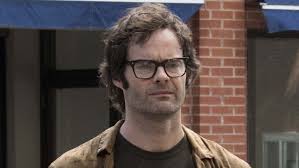 The language is ridiculously and unnecessarily crude, using the “F” word like a baker does flour. Granted all of them subtly reverted back to elements of their childhood during the course of the movie – Bill’s stutter and Eddie’s psychosomatic asthma for examples. Childhood Richie had a marked dependence on profanity as a defense mechanism against his own insecurities, so adult Richie’s profane filled vocabulary should not surprise us, but even so, the repetition became gratuitous.
The language is ridiculously and unnecessarily crude, using the “F” word like a baker does flour. Granted all of them subtly reverted back to elements of their childhood during the course of the movie – Bill’s stutter and Eddie’s psychosomatic asthma for examples. Childhood Richie had a marked dependence on profanity as a defense mechanism against his own insecurities, so adult Richie’s profane filled vocabulary should not surprise us, but even so, the repetition became gratuitous.
Benjamin Wallfisch returns to create yet another creepy musical backdrop which functions as a character in its own right.  Heavy, and effectively random use of oppressive jarring percussions and wandering dissonant acrobatics on flute and violin provide a disjointed, otherworldly, off balanced and forcefully unsettling soundtrack for most of the movie accompanying Pennywise, which music occasionally, like brief moments of sunshine during a terrible storm, give way to lovely, lyrical, and melancholic passages representing the children and their adult dopplegangers.
Heavy, and effectively random use of oppressive jarring percussions and wandering dissonant acrobatics on flute and violin provide a disjointed, otherworldly, off balanced and forcefully unsettling soundtrack for most of the movie accompanying Pennywise, which music occasionally, like brief moments of sunshine during a terrible storm, give way to lovely, lyrical, and melancholic passages representing the children and their adult dopplegangers.
 IT: C2 is a solid horror movie with an intelligent sub-text but certainly appropriate only for older teens and up given the language, the extreme violence, and multiple scenes of physical, emotional, verbal and implied sexual abuse.
IT: C2 is a solid horror movie with an intelligent sub-text but certainly appropriate only for older teens and up given the language, the extreme violence, and multiple scenes of physical, emotional, verbal and implied sexual abuse.
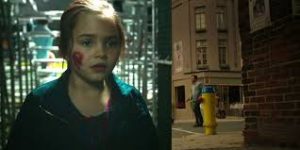 And as I have already mentioned – more horrifying than Pennywise’s presence on screen was the attendance by a number of early teens and even YOUNGER audience members, some of whom were with parents who REALLY should have known better. As if the movie IT: C2 was not inappropriate enough for these children, the previews certainly were, including stories which featured real world violence and pole-dancing strippers. If a movie is “R” rated, as IT is, then authority figures should realize previews are going to be “R” rated as well and often not just for gore and jump scares.
And as I have already mentioned – more horrifying than Pennywise’s presence on screen was the attendance by a number of early teens and even YOUNGER audience members, some of whom were with parents who REALLY should have known better. As if the movie IT: C2 was not inappropriate enough for these children, the previews certainly were, including stories which featured real world violence and pole-dancing strippers. If a movie is “R” rated, as IT is, then authority figures should realize previews are going to be “R” rated as well and often not just for gore and jump scares.
So if you liked Chapter ONE IT then you’ll find IT: Chapter Two very satisfying, with creatively gross monsters and an interesting underlying analogy about learning to heal from childhood trauma.
But PLEASE avoiding traumatizing your own child with this movie and leave the kids at home.
THEY MIGHT BE GIANTS – TAKE A ROAD LESS TRAVELED STARRING AMERICA’S FINEST ACTOR
SHORT TAKE:
This first is in a series of movies which I will review which are unlike any other films. I begin with a gentle comedy fantasy, starring the greatest American actor who ever lived, with a new perspective on Sherlock Holmes.
WHO SHOULD SEE THESE:
Depends on the movie – but the range for ones I have in mind are about mid-teen and up, for plot topics, or language, or because younger kids would simply be bored or frightened. As always, but especially with these since there is often little to compare them to – you should check them out first before showing them to your kids.
INTRODUCTION:
A preponderance of movies now-a-days are derivative. You can’t blame movie executives for it really. When you are sinking millions of dollars of other people’s money into a project it is a great comfort to know it is similar to another one that made a profit. And I love formula movies. There is an enjoyable reliability in the anticipation of a familiar theme – like listening to a variation of a song you love by a different artist. Like Buble’s upbeat jazzy version of the originally clunky Spiderman theme song. Or Sia’s creepily ominous version of “California Dreamin'” from the recent disaster movie San Andreas.
But every now and again I find a unique little one-off which makes it fondly to my list of favorite movies. By unique, I mean it has no sequels, no prequels, and no one (yet) has plans to remake it. They are not part of a franchise, few people have ever even heard of them, and if you go on Amazon to look for them the “Customers Who Watched This Item Also Watched…” you will not find a single item anything like it. Oh, you’ll find a list of other movies the actors have been in or the director has made or a stab at the genre, but NOTHING approaching these sparkling gems in the cinematic firmament.
Here is the first of my favorites in no particular order – aside from the fact it stars my favorite actor ….. ever.
LONG TAKE:
THEY MIGHT BE GIANTS (1971)
 I think George C. Scott is probably one of, if not THE best American actor ever. (Sorry Marlon).
I think George C. Scott is probably one of, if not THE best American actor ever. (Sorry Marlon). 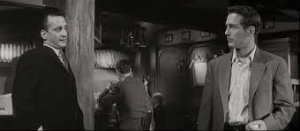 His filmography spanned decades.
His filmography spanned decades. 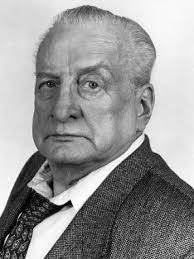 He threw himself completely into every role but never lost sight of the idea it was a job and he a performer whose responsibility it was to entertain his audience the best way he knew how. His career was as varied as his thespian skills were intense. At home in comedies, mysteries, biographies, romances, classics, horror, dramas, you name it,
He threw himself completely into every role but never lost sight of the idea it was a job and he a performer whose responsibility it was to entertain his audience the best way he knew how. His career was as varied as his thespian skills were intense. At home in comedies, mysteries, biographies, romances, classics, horror, dramas, you name it,  he played cops and lawyers, generals and sleaze-balls, gangsters and scientists. He was an attorney in Otto Preminger’s 10 Oscar nominee 1959’s
he played cops and lawyers, generals and sleaze-balls, gangsters and scientists. He was an attorney in Otto Preminger’s 10 Oscar nominee 1959’s 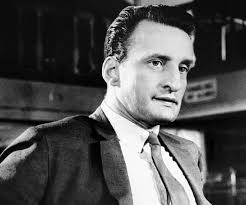 Anatomy of a Murder, and the off-the-wall
Anatomy of a Murder, and the off-the-wall 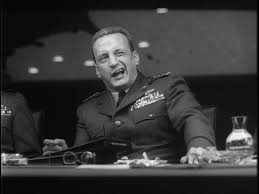 General Turgidson in Kubrick’s 1964 classic 4 Oscar nominee Dr. Strangelove. He was the man of choice in a version of Scrooge,
General Turgidson in Kubrick’s 1964 classic 4 Oscar nominee Dr. Strangelove. He was the man of choice in a version of Scrooge, 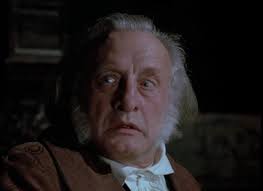 Edward Rochester with a Jane Eyre played by Suzanna York (who later played Christopher Reeve’s Superman’s mom), the Beast opposite his then wife Trish Van deVere’s Belle, Fagin in Oliver Twist, Mussolini in a biodrama about the dictator, one of 12 Angry Men, the captain in a version of the Titanic, a hit man in a Stephen King movie, and the stalwart and heroic
Edward Rochester with a Jane Eyre played by Suzanna York (who later played Christopher Reeve’s Superman’s mom), the Beast opposite his then wife Trish Van deVere’s Belle, Fagin in Oliver Twist, Mussolini in a biodrama about the dictator, one of 12 Angry Men, the captain in a version of the Titanic, a hit man in a Stephen King movie, and the stalwart and heroic  General George S. Patton in 1970’s amazing Patton, the latter a winner of 7 Oscars including best director, movie, screenplay, and lead actor.
General George S. Patton in 1970’s amazing Patton, the latter a winner of 7 Oscars including best director, movie, screenplay, and lead actor.
Mr. Scott turned down both his Best Supporting nomination for The Hustler and stuck to his guns turning down even the Oscar for his win in Patton. He maintained the Oscars had morphed from a friendly dinner among compatriots to a “meat parade” with “contrived suspense for economic reasons,” and that he was not in competition with his fellow thespians.
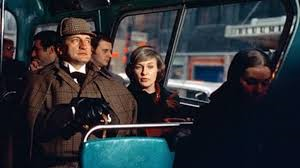 THEN, right after his definitive turn as Patton, at what was then the height of his career, he made a little known film for a small budget,
THEN, right after his definitive turn as Patton, at what was then the height of his career, he made a little known film for a small budget, 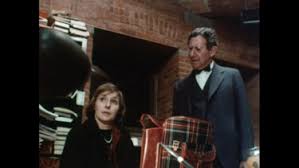 whose virtues rest squarely on the shoulders of the actors. They Might Be Giants was written by James Goldman, directed by Anthony Harvey, and with music composed by John Barry (who also scored 11 Bond films), were the same three men who crafted the brilliant Lion in Winter.
whose virtues rest squarely on the shoulders of the actors. They Might Be Giants was written by James Goldman, directed by Anthony Harvey, and with music composed by John Barry (who also scored 11 Bond films), were the same three men who crafted the brilliant Lion in Winter.
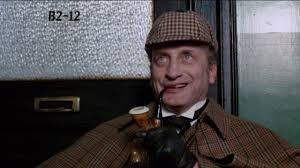 The premise of They Might Be Giants is that Judge Justin Playfair (don’t look at me, I didn’t make up the name, but this will give you a clue as to the film’s ambiance), is so stricken by grief over the loss of his wife that he has retreated into believing he is Sherlock Holmes.
The premise of They Might Be Giants is that Judge Justin Playfair (don’t look at me, I didn’t make up the name, but this will give you a clue as to the film’s ambiance), is so stricken by grief over the loss of his wife that he has retreated into believing he is Sherlock Holmes. 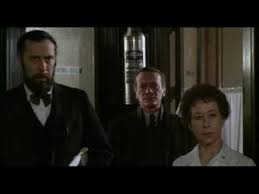 His brother, with motives other than Playfair’s best interests, seeks out a psychiatrist to have him committed. Unfortunately, or fortunately, her name just happens to be Mildred …. Watson.
His brother, with motives other than Playfair’s best interests, seeks out a psychiatrist to have him committed. Unfortunately, or fortunately, her name just happens to be Mildred …. Watson. 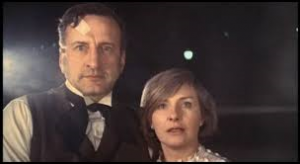 Dr. Watson is gently played by Joanne Woodward, who with a considerable acting track of her own, was the wife and long-time working companion of Paul Newman.
Dr. Watson is gently played by Joanne Woodward, who with a considerable acting track of her own, was the wife and long-time working companion of Paul Newman. 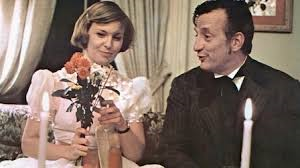 Scott is (one viewer noted) “majestic” in this quirky mystery-romance, describing the film as a “delicate … comedy/fantasy”. I couldn’t agree more. Without giving ANY spoilers, I will admit this is not a perfect film, but what is there is creative, memorable, and delightful.
Scott is (one viewer noted) “majestic” in this quirky mystery-romance, describing the film as a “delicate … comedy/fantasy”. I couldn’t agree more. Without giving ANY spoilers, I will admit this is not a perfect film, but what is there is creative, memorable, and delightful.
So, as Robert Frost might encourage, take the road “…less traveled by,” and check out this small movie aptly named They Might be Giants.
It is also available on Amazon HERE.
